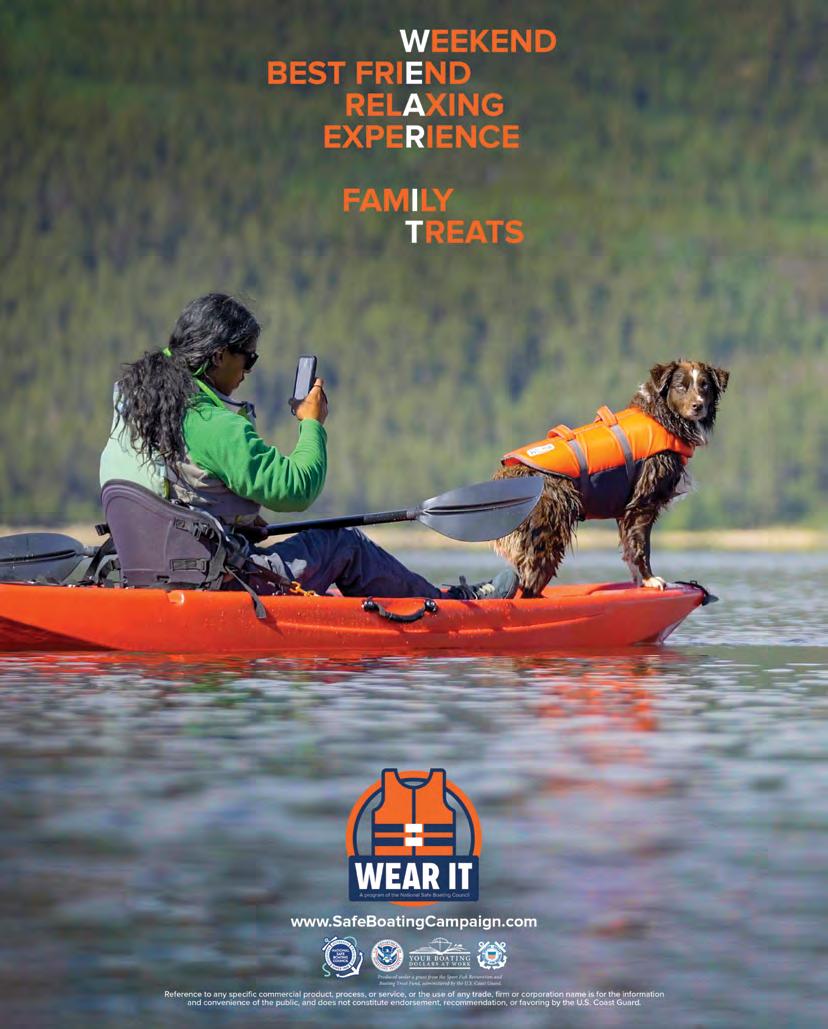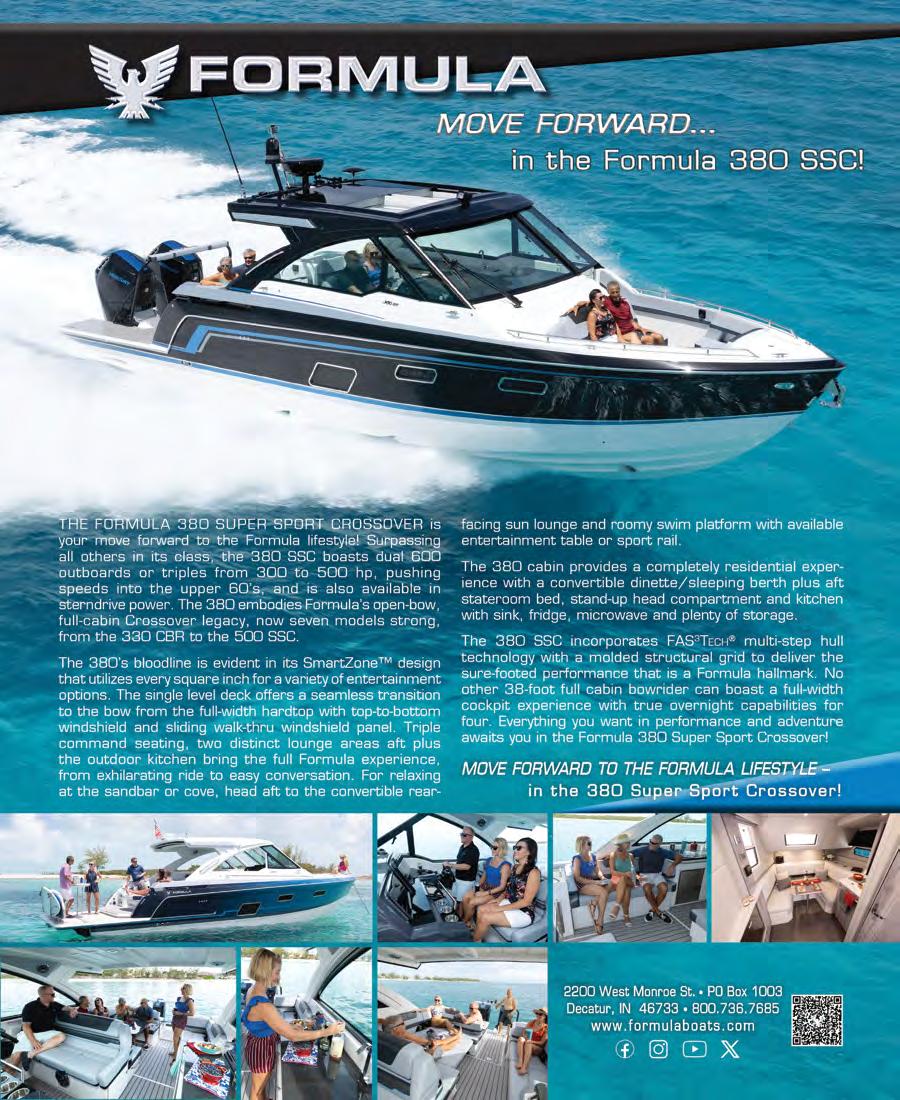











A fine Finnish cruiser

LE

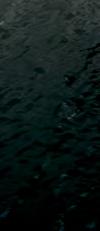
The 2025 model gets a fresh redesign
This December marks 60 years since salmon eggs were brought to the Great Lakes

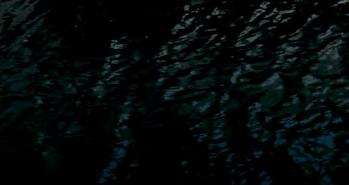
ONE STEP AT A TIME
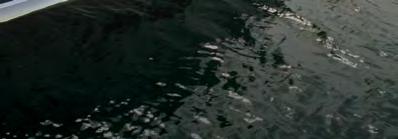
A year-long adventure to the Bahamas and back
Prince Edward Island: Canada’s smallest province has much to be discovered
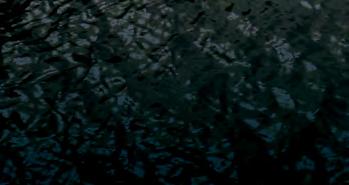

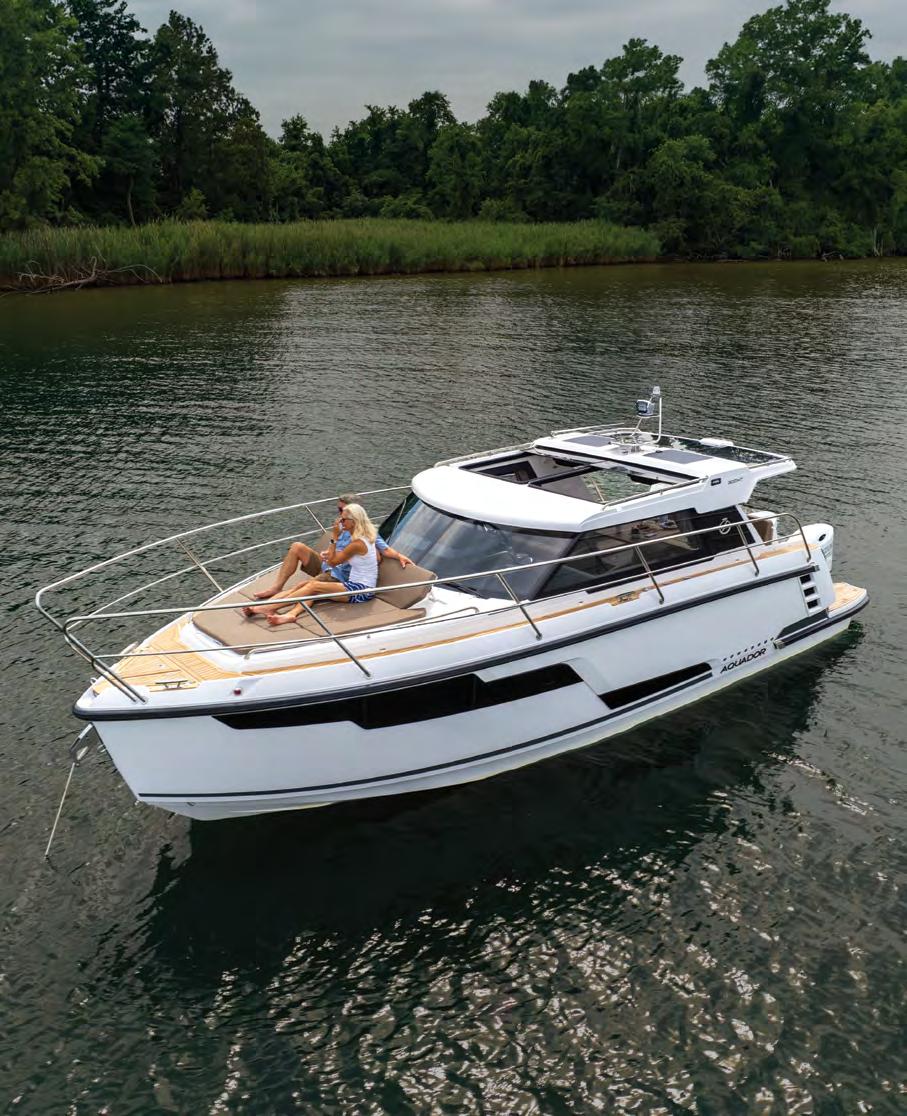



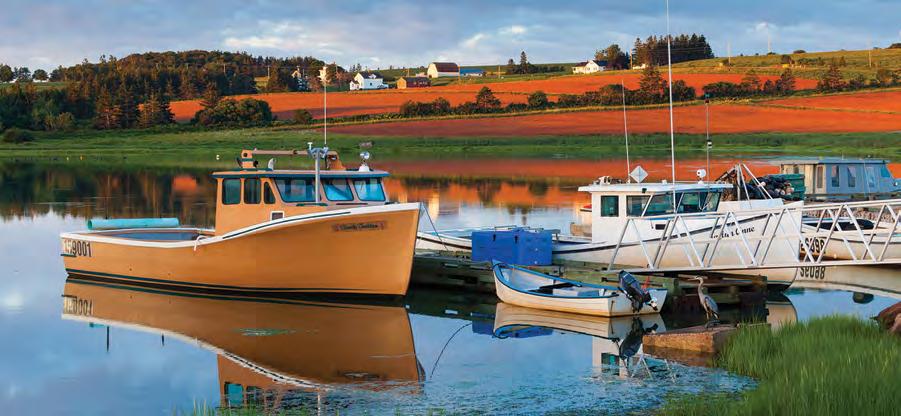
Come get your fill of famous PEI oysters and mussels!

34 Aquador 300 HT Scandinavian invasion. By Charles Plueddeman
38 Tiara 43 LE Highly polished. By Chuck Warren
42 The Turning Point
Sixty years ago this December, the first batch of coho salmon eggs arrived in Michigan from the west coast, forever changing the Great Lakes and creating one of the most spectacular freshwater sport fisheries in the world.
By Craig Ritchie
44 Kasablanca
A young Michigan family, burned out from the daily grind, sails to the Caribbean in search of adventure.
By Allison Hoogerwerf
48 Port of Call: Prince Edward Island
Paradise Found: Nestled along the south shore of the Gulf of St. Lawrence, Prince Edward Island may be Canada’s smallest province, but it stands unmatched as a unique and magnificent port of call for cruising boaters. By Craig
Ritchie
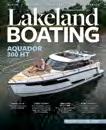

The Aquador 300 HT combines clever, efficient design with outstanding Finnish detailing, making it an intriguing new option for family dayboating and light cruising.



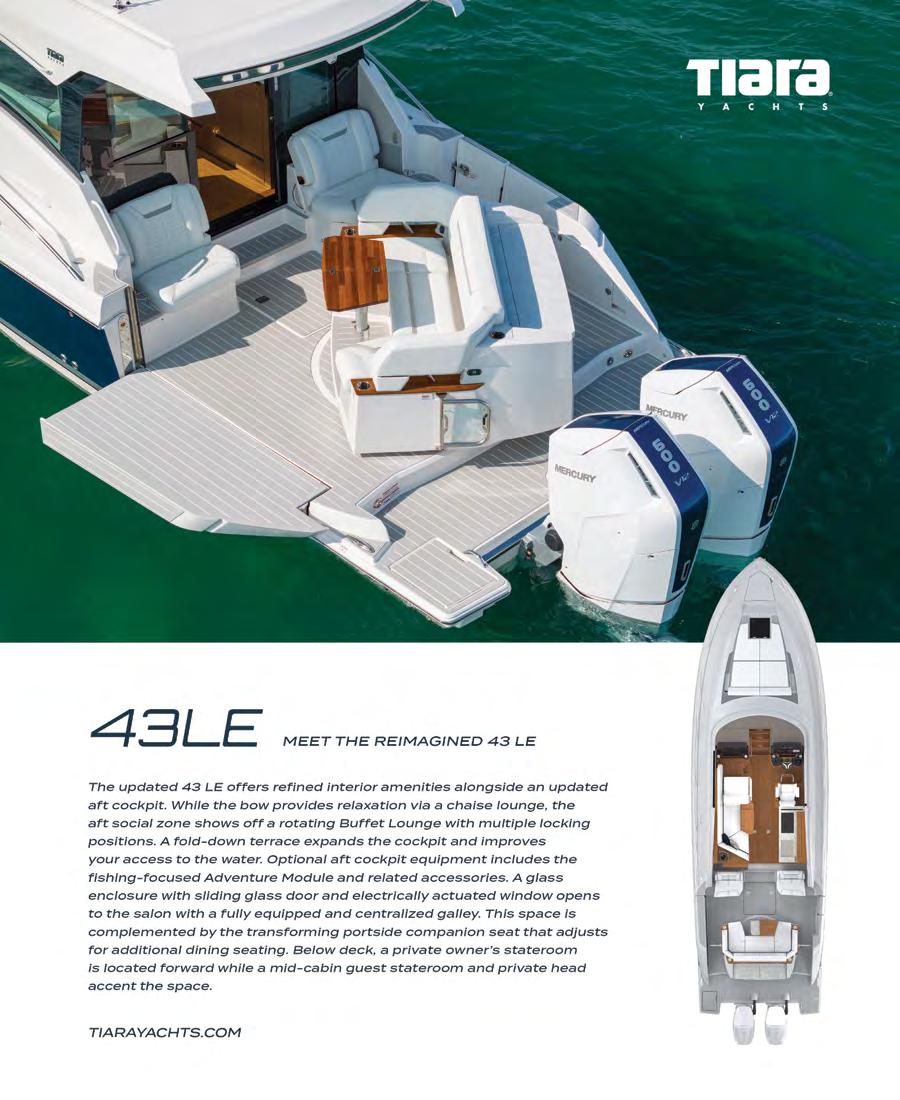
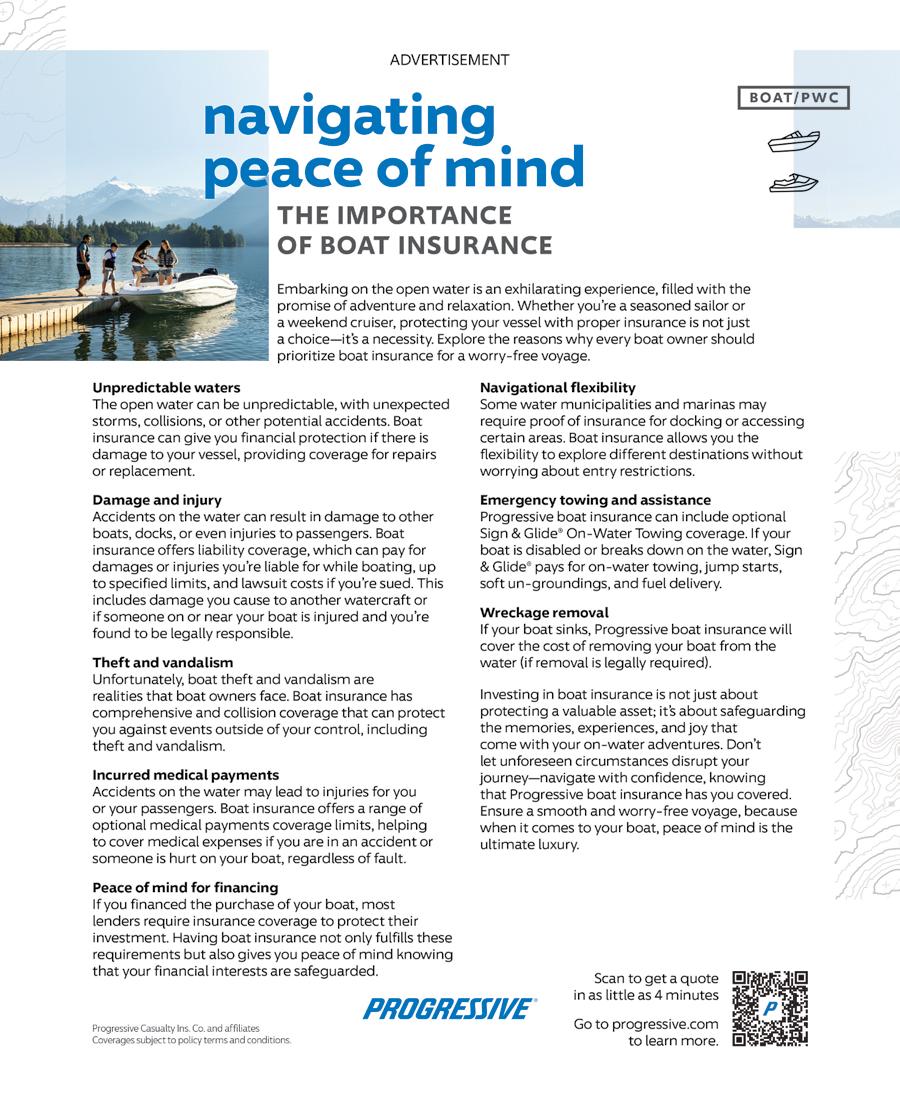


















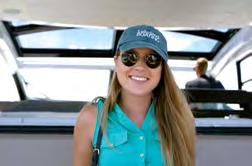
This year has been an exciting year of change for us here at Lakeland Boating. We had a few design updates (most notably a new logo!), added more content to our website (you can now find all our features and columns online) and introduced a new fishing column. While we look toward the new year, we have even more exciting announcements. Starting in January, we will launch not only a monthly column following the Bohonek family as they cruise the Great Loop, but also a real-time, web-based series following Karly and Evan Nietzel as they depart on the Great Loop! Two columns are coming to an end — “Beneath the Surface” by Heather Steinberger and “Safety First” by Helen Aitken — as we make room for new content next year. We want to thank Heather and Helen for all their amazing work over the past few years!
This issue is packed with fun features. Read about the 60th anniversary of salmon being brought to the Great Lakes (p. 42); learn more about picturesque Prince Edward Island, Canada’s smallest province (p. 48); and discover how one Michigan family, burnt out after the pandemic, took their young family on a once-in-a-lifetime trip to the Bahamas (p. 44). And if you’re still in need of a gift for your favorite boaters, flip to our Holiday Gift Guide to get some ideas (p. 18).
Happy holidays!
Do you have a story idea you’d like to suggest? Email me at kbush@lakelandboating.com to share your ideas.

AREAS MENTIONED IN THIS ISSUE

HEATHER STEINBERGER
Heather is an awardwinning writer/editor who has specialized in boating, travel and outdoor adventure for more than 25 years. She grew up on the shores of Lake Michigan and enjoys powerboating, sailing, and stand-up paddleboarding with her husband, professional photographer Richard Steinberger, and daughter, Johanna.
READ HER STORY ON P. 22
Charles has been writing about marine engine technology, and high-performance and trailerable power–boats since 1986. He lives in Wisconsin and still loves to smell two-stroke exhaust in the morning.

READ HIS STORY ON P. 34

CRAIG RITCHIE
Born in Toronto, Craig named his first boat Bed in order to explain occasional absences from work. Whenever anyone asked, he would cough loudly and mumble about having spent the day in Bed. The key, he says, was to never forget the sunscreen.
READ HIS STORIES ON P. 42 AND P. 48
56
ALLISON HOOGERWERF
Allison is a freelance writer and an adventure enthusiast. She and her family are often found sailing, hiking and exploring the beautiful world around them.

READ HER STORY ON P. 44
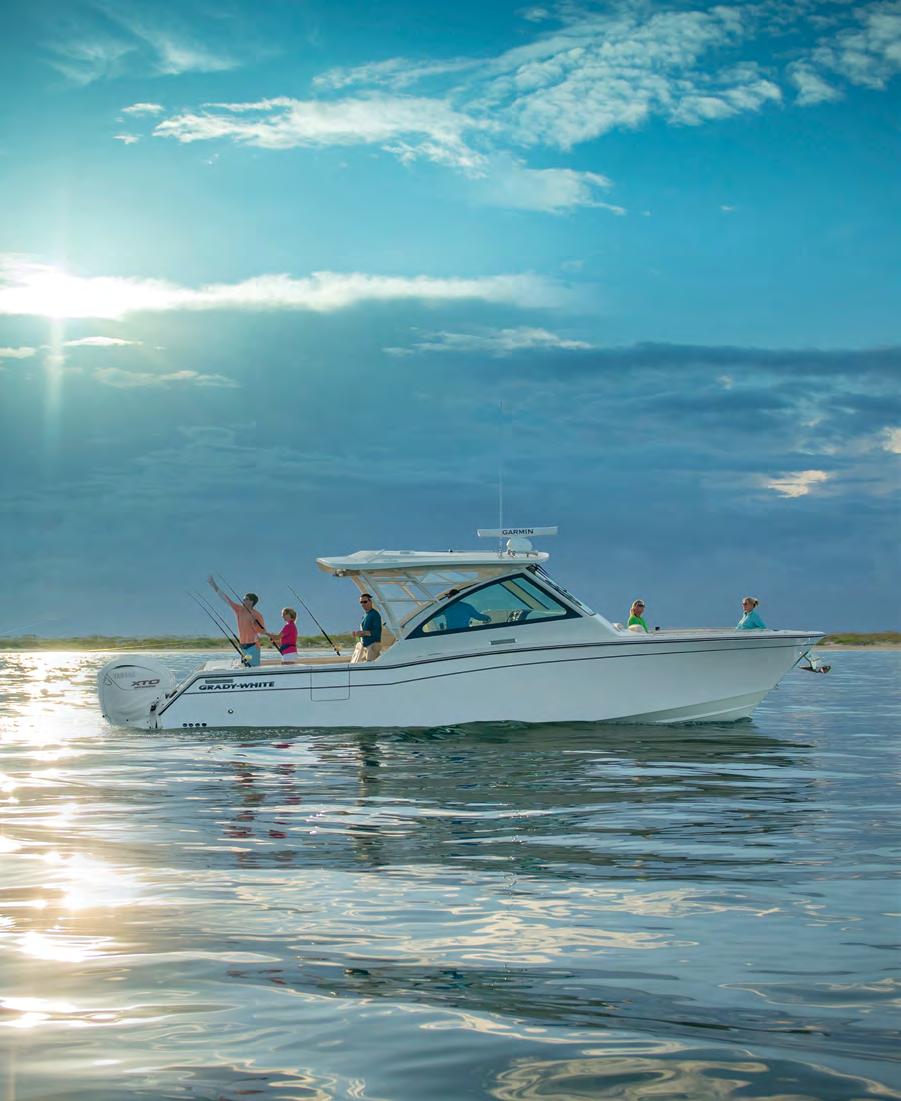






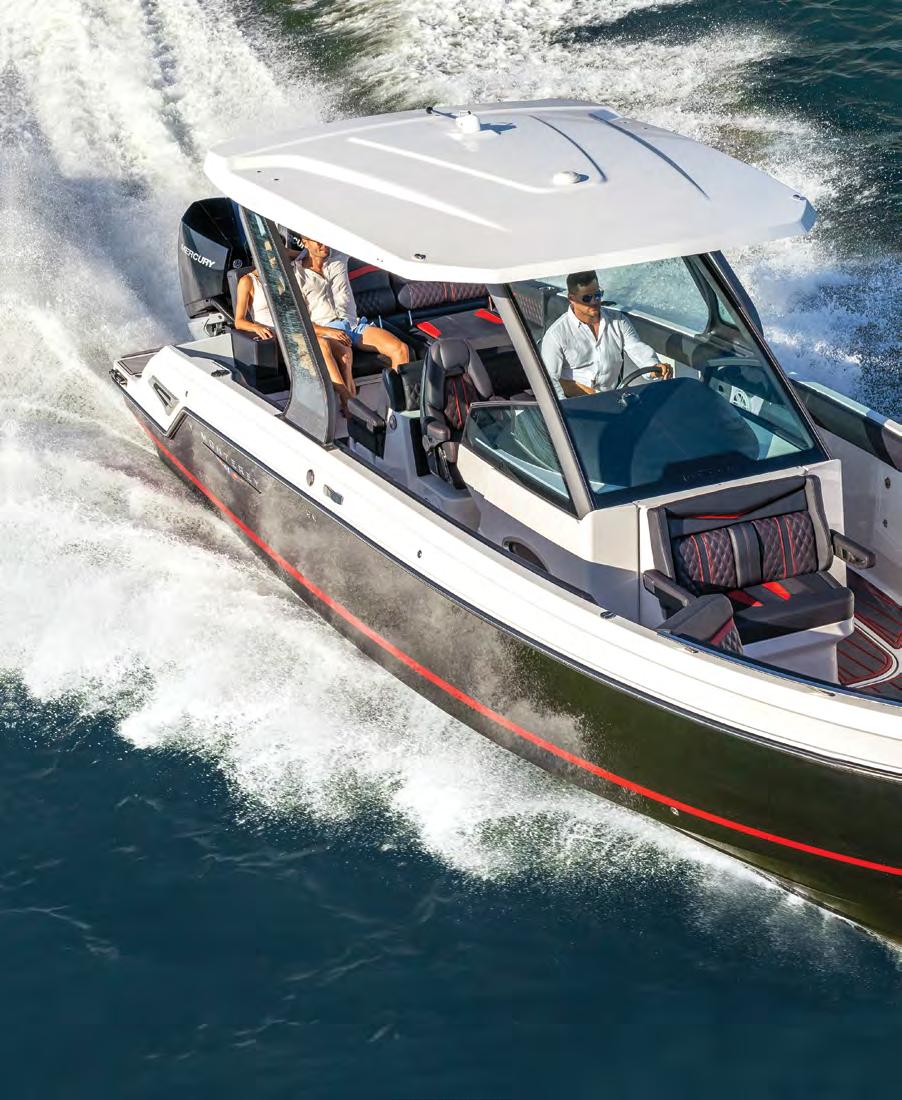
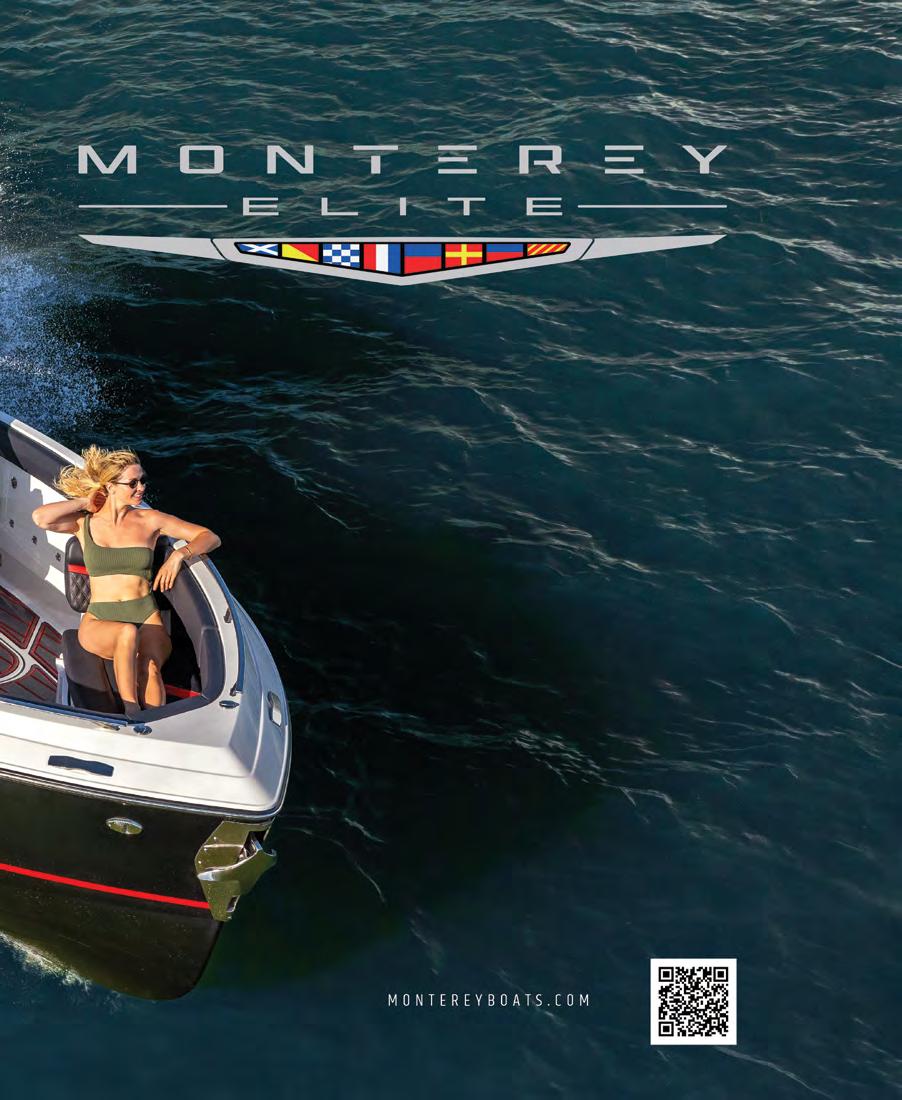
Start them young
NOVEMBER/DECEMBER 2024
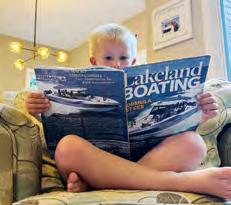


I took this photo a few weeks ago of my 4-year-old. It was not staged. I bring these magazines home for him and caught the perfect moment. We own a marina in Holland, Michigan, and enjoy spending a lot of time on the water!
—Matt DenHerder, Yacht Basin Marina, Holland, MI

This picture was taken by our daughter, Amy, who was visiting from New York City. Our port is Holland, Michigan. We had planned to salmon fish but decided to drop anchor off the beach and sunset swim instead. —Tim and Sandy Dust (aboard DUSTER), Holland, MI
Lake Lens
We want to see the gorgeous Great Lakes from your point of view! Send a high-resolution photo (at least 1 MB) and a short write-up about that photo to KBUSH@ LAKELANDBOATING.COM. Please put “Lake Lens” in the subject line. If we publish your submission, you’ll win a Lakeland Boating hat!
Name Game
We’re always on the lookout for clever and interesting boat names! Send us a short write-up about why you chose your boat name, along with your name, your home city and state, and a high-res photo of your boat (at least 1 MB). Send to KBUSH@LAKELANDBOATING.COM and put “Name Game” in the subject line.
Look Good in a Lakeland Boating Hat!



Need a gift for your favorite boater? Our Lakeland Boating hat is constructed from soft cotton twill for a great fit. Leather band adjustment in back with antiqued brass closure. Available in weathered navy or Nantucket red. One size. $24.95 + S&H. To order, visit LAKELANDBOATING.COM/STORE.

“Dock Box” are not necessarily those of the Lakeland Boating. Letters may be edited for length and clarity.
VOLUME LXXVIII, NO. 11
PUBLISHER
Linda O’Meara
PUBLISHER IN MEMORIUM
Walter “Bing” O’Meara
EDITORIAL STAFF
Editorial Director: Kate Bush
Assistant Editor: Abby Thorpe
CREATIVE STAFF
Art Director/Production Manager: Christy Tuttle Bauhs
CONTRIBUTORS
Glenn Hayes, Allison Hoogerwerf, Capt. Frank Lanier, Patti McCleery, Charles Plueddeman, Craig Ritchie, Heather Steinberger, Chuck Warren
BUSINESS STAFF
National Sales: Mark Conway
Director of Business Development: Joe D’Onofrio Accounting: Diane Fairchild
EDITORIAL & ADVERTISING OFFICE
1555 Sherman Ave. / Suite 313 / Evanston, IL 60201 312-276-0610 / Fax: 312-276-0619
info@lakelandboating.com
LAKELANDBOATING.COM
CLASSIFIED ADVERTISING
1555 Sherman Ave. / Suite 313 / Evanston, IL 60201 312-276-0610 x. 24 / Fax: 312-276-0619
CBAUHS@LAKELANDBOATING.COM
SUBSCRIPTIONS
Lakeland Boating
P.O. Box 386, Lincolnshire, IL 60069 847-504-8475
O’MEARA-BROWN PUBLICATIONS INC
President: Linda O’Meara
Secretary: Timothy Murtaugh
Lakeland Boating (ISSN 0744-9194) Copyright 2024, by O’Meara-Brown Publications, Inc. is published eleven times per year (except December) by O’Meara-Brown Publications, Inc. / Business/Accounting and Editorial Offices: 1555 Sherman Ave. Suite 313, Evanston, IL 60201, 312-276-0610. / Call 847-504-8475 to subscribe. Lakeland Boating, P.O. Box 386, Lincolnshire, IL 60069 (U.S.). Annual subscription rates: United States: $24.95 per year; International and Canadian: $39.95 per year, includes 7% G.S.T. tax (G.S.T. 894095074-RT 0001) and $12 postage included. Single copies are $4.99 for U.S. and Canada. Only U.S. funds are accepted. Periodical postage paid at Evanston, IL and additional mailing offices. / POSTMASTER: Please send address changes to Lakeland Boating, P.O. Box 386, Lincolnshire, IL 60069. / Lakeland Boating is a registered trademark of O’Meara-Brown Publications, Inc., Evanston, IL. Published as Lakeland Yachting 1946-1955. / Unsolicited work may be submitted at the creator’s own risk. Lakeland Boating assumes no responsibility or liability for unsolicited material. All submissions must be accompanied by a selfaddressed envelope with sufficient return postage. / All published photos are courtesy of the manufacturer, unless otherwise noted.





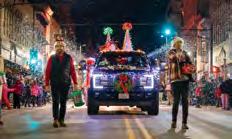

NOV 1 – 3
Kelleys Island Owl Fest Kelleys Island, OH
LAKEERIEISLANDS CONSERVANCY.ORG
NOV 1 – 3 & 8 – 10
1 Toast the Season Leelanau, MI LPWINES.COM
NOV 8 – 16
Traverse City Beer Week Traverse City, MI TRAVERSECITY.COM/TCBW
NOV 10
Edmund Fitzgerald Memorial Service Virtual SHIPWRECKMUSEUM.COM
NOV 15 – 17
2 Unwrapping Sturgeon Bay and Christmas by the Bay Weekend Sturgeon Bay, WI STURGEONBAY.NET
NOV 16
Shipwrecks & Scuba Huron, OH SHIPWRECKSANDSCUBA.COM
NOV 16 – JAN 5
Winter Festival of Lights Niagara Falls, ON WFOL.COM
NOV 22
Lighted Santa Parade and Tree Lighting St. Clair, MI STCLAIRONTHERIVER.COM
Luminary Festival St. Joseph, MI STJOETODAY.COM
NOV 22 – 23
Capture the Spirit Sister Bay, WI SISTERBAY.COM
NOV 22 – DEC 24
Christkindlmarket Chicago Chicago, IL CHRISTKINDLMARKET.COM
NOV 23 – DEC 21 (SAT & SUN)
3 Kerstmarkt Holiday Market Holland, MI KERSTMARKT.WORDPRESS.COM
NOV 27
4 Lakeshore Holiday Parade Manitowoc, WI MANITOWOC.ORG
NOV 29
Holiday Parade and Tree Lighting Charlevoix, MI VISITCHARLEVOIX.COM
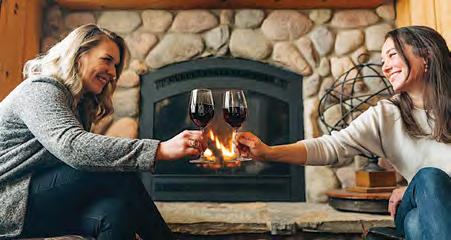
NOV 29 – DEC 1; DEC 6 – 8; DEC 13 – 15
Christkindlmarkt Sister Bay, WI
DOORCOUNTYCHRISTMAS MARKET.COM
NOV 29 – 30
Holly Days Egg Harbor, WI
EGGHARBORDOORCOUNTY.ORG
NOV 30
Holly Berry Arts & Craft Fair Frankfort, MI
FRANKFORT-ELBERTA.COM
DEC 6
5 Holiday Open House Petoskey, MI PETOSKEYDOWNTOWN.COM
Light up Vermilion Vermilion, OH MAINSTREETVERMILION.ORG
DEC 6 – 7
Christmas in the Village Escanaba, MI UPSTEAMANDGASENGINE.ORG
Lakeside Christmas Lakeside, OH LAKESIDEOHIO.COM
DEC 6 – 8
Merry & Bright Weekend St. Joseph, MI STJOETODAY.COM
DEC 6 –15
Old World Christmas Market Sheboygan, WI OSTHOFF.COM
DEC 6 – 21
Magic at the Mill Holland, MI CITYOFHOLLAND.COM
DEC 7
Christmas in Clayton & Christmas Parade Clayton, NY 1000ISLANDS-CLAYTON.COM
Christmas in the Village Ephraim, WI EPHRAIM-DOORCOUNTY.COM
Christmas Tree Ship Chicago, IL CHRISTMASSHIP.ORG
Christmas Tree Ship Day Manitowoc, WI WISCONSINMARITIME.ORG
Light Up the Night & Soup Cook Off Bellaire, MI BELLAIRECHAMBER.ORG
Merrytime Christmas Marine City, MI VISITMARINECITY.COM
Santa Hustle 5k Chicago, IL SANTAHUSTLE.COM/CHICAGO
DEC 7 – 8 6 Julebyen Knife River, MN JULEBYEN.ORG
DEC 14 A Colonial Christmas Mackinaw City, MI MACKINACPARKS.COM
DEC 14 – 15 Yuletide in the Harbor Sackets Harbor, NY SACKETSCHAMBER.COM
DEC 31
New Year’s Eve Walleye Drop Port Clinton, OH WYLIEWALLEYEFOUNDATION.COM
New Year’s Eve Celebration and Cherry Drop Sister Bay, WI SISTERBAY.COM
Traverse City New Year’s Eve CherryT Ball Drop Traverse City, MI CHERRYTBALLDROP.ORG

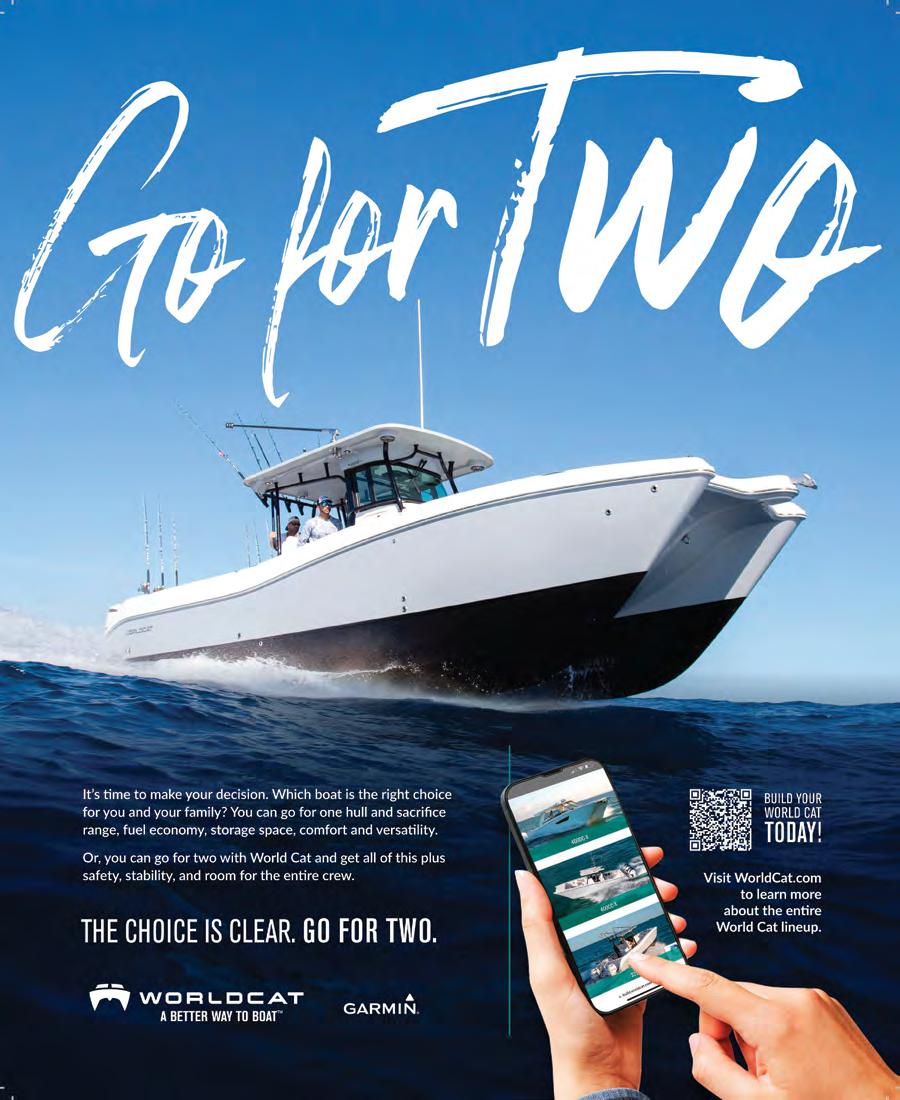


Previously available only on boats up to 36 feet, the Seakeeper Ride underway stabilization product line is now available for boats up to 42 feet. The two new models — the Seakeeper Ride 750 and Seakeeper Ride 750 Quad — are designed for boats 37 to 42 feet and eliminate up to 70% of underway pitch and roll.





The Seakeeper Ride 750 system consists of two larger controllers and will fit most vessels in this size range, while the Seakeeper Ride 750 Quad system has four smaller controllers and is suitable for unique transoms that may have hull design elements that restrict available space.
The Seakeeper Ride 750 system retails for $17,500 and the Seakeeper Ride 750 Quad system retails for $20,500.
Visit SEAKEEPER.COM for more info.

Sabre Yachts has added to its fleet with the newly introduced Sabre 51 Salon Express, featuring enhanced social spaces in both the cockpit and foredeck, and twin Volvo IPS 800 engines controlled by the Sabre digital switching system and the Sabre connect app.
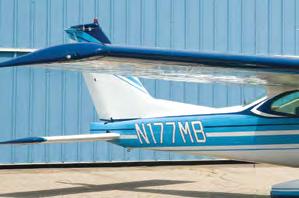
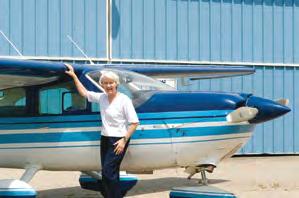


The trailblazing pilot photographer Marjorie “Marge”
Beaver passed away on July 28, 2024 at the age of 89.
Marge combined her twin passions for flying and taking pictures into an aerial photography business, Photography-Plus, that documented much of Michigan from above. Her aerial photography was used in all five Lakeland Boating “ Ports o’ Call” Great Lakes cruising guides.
“Bing was so impressed with her work (way before drones) and she did all the aerial photos of the ports for all five cruising guides,” says Lakeland Boating Publisher Linda O’Meara, remembering late publisher Bing O’Meara. “People always told us how beneficial it was for them to have the aerial photos of the entrances to different ports when they were cruising. Bing was always in awe of her flying her own plane — strapped in, leaning out, taking photos!”
Marge continued to fly her beloved Cessna Cardinal well into her 80s and she operated her business for over 40 years. When she wasn’t flying her plane, Marge enjoyed bowling with her husband and friends,
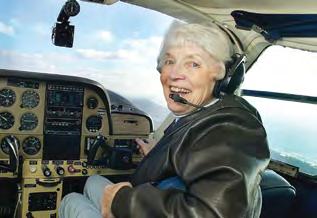
and raising her five children. She also had a passion for gardening and growing beautiful orchids in her greenhouse. She cared deeply about the environment and was a strong advocate of organic and sustainable farming practices. Those who knew her best describe her as compassionate, thoughtful and extremely generous.
Marge is survived by three of her children, 11 grandchildren and four great-grandchildren.






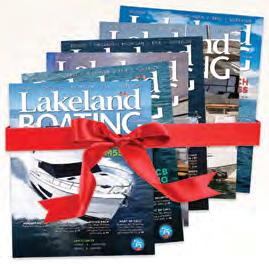
Formula Launches New 457 Center Console
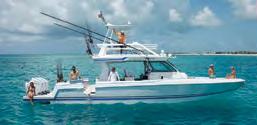
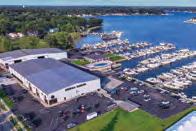
Construction has started at Keenan Marina’s Spring Lake, Michigan location, where new 60-foot slips and a wall accommodating boats up to 150 feet will be built. The new slips will be available summer 2025.
Debuting at the 2024 Fort Lauderdale International Boat Show, the brand-new Formula 457 Center Console Fish (CCF) celebrates the finish and amenities of Formula’s renewed entry into the CC market.
The 457 follows Formula’s recent introduction of the 387 Center Console Fish and Sport models. It measures 45 feet, 7 inches, and is powered by triple Mercury Verado 600-hp engines.
Accented with multicolored LED lighting, a center ladder and an access hatch, the hardtop features a compound curved windshield with power-opening forward glass and washer/wiper combo. Customdesigned triple helm seats feature individual sit/ stand/rest positions, electrically adjusting fore and aft, and foldaway armrests. The captain and crew enjoy a standard 18,000 BTU air conditioning system plus an impressive electronics suite, including twin 22-inch Raymarine or Garmin widescreen color chartplotters and Mercury Joystick Piloting.
Angling amenities include dual 50-gallon, pressurized livewells aft, port and starboard fishboxes with macerators, and in-floor storage with YETI buckets. Choose to add an upper helm station on the CCF if you wish to boost your angling game!
Down below, features include 6-foot, 6-inch headroom, a U-shape lounge/double berth, a galley with stainless pull-out fridge and microwave, and a molded private head compartment with a separate stall shower.
For more information, visit FORMULABOATS.COM.
Nimbus

Nimbus Group — the parent company of Nimbus, EdgeWater Boats, Aquador and more — is expanding its dealership network in North America. The new dealerships include Longshore Boats in Charleston, South Carolina; Nautimar in the Dominican Republic; Len’s Cove in Eastern Ontario, Canada; and Paris Marine in Western Ontario, Canada.
Len’s Cove is now the authorized dealer for EdgeWater Power Boats in Eastern Ontario, serving the greater Kingston and Ottawa areas.
Paris Marine, a third-generation, family-owned and operated dealership located in Peterborough, Ontario, will now also sell EdgeWater Power Boats in Canada, with a focus on the multitude of lakes just north of Lake Ontario.
For more information, visit NIMBUSGROUP.SE.

At 38 feet, 10 inches, Wellcraft’s brand-new 38 T-Top offers easy access to the water and is packed with entertainment features for thrill-seekers.
“This crossover concept is a multi-role center console with a unique combination of performance, seaworthiness and entertaining space, which will attract younger boaters seeking thrills on the water,” says Product Manager Luka Modrijan.
The Wellcraft 38 T-Top’s innovative swim platform offers unmatched water-access, while the boat boasts impressive seating capacity. The aft cockpit lounge is the largest in its class. The boat’s dedicated fishing storage, rod holders and command livewell ensure it also conquers the needs of avid anglers.
This model comes with a fully equipped cabin, including a double berth, a separate head compartment and a shower. Equipped with twin or triple outboard engines, it can easily reach speeds of up to 57 mph.
The first model will make its debut at the 2025 Miami International Boat Show. Visit WELLCRAFT. COM for more information.
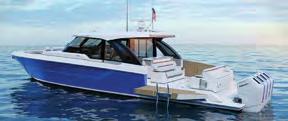
Tiara Yachts is expanding its Luxury Sport line with the 56 LS, the largest of Tiara’s outboard models to date. Powered by quad Mercury Verado 600 V12 outboard engines, the 56 LS reaches a thrilling top-speed of 57 mph.
The integrated electronics package includes Garmin Marine Navigation Systems. Sophisticated exterior and interior amenities include several social spaces, a fully equipped galley that overlooks the aft cockpit, port and starboard hullside terraces, and the choice of an aft cockpit module focused on either entertaining or fishing. The 56 LS accommodates five guests overnight with two staterooms and two private heads.
The 56 LS will debut at the 2025 Miami International Boating Show. Visit TIARAYACHTS.COM to learn more.

The same manufacturer that’s been producing awardwinning luxury Avalon and Tahoe pontoons for 50 years has launched a new brand: Aura Pontoons. Aura Pontoons exclusive EF-Tech (Endure FlexForm Technology) is a cutting-edge innovation in wall, helm and seat base construction that’s an evolution of rotocast, delivering enhanced durability and performance.
Instead of traditional hardwired stereos, Aura pontoons are equipped with two portable JBL Flip 6 speakers. Charging is made easy with built-in USB charging ports located near each speaker cradle.
Aura’s seating features moveable backrests that can be positioned exactly where you need it. Aura pontoons are available in 19-, 21- and 23-foot options, all on an 8.5-foot-wide beam, and in four different colorways.
For more information, visit AURAPONTOONS.COM.
Bay Marine founder Francis “Fran” Felhofer passed away in September at the age of 91. Fran was well-known not only as an entrepreneur and community leader but as a dedicated husband, father, grandfather, great-grandfather and friend.
Fran’s entrepreneurial mindset transformed Bay Marine from the Cherryland service station his father started into a thriving marine enterprise, now led by sons Matt and Mark. His inspired vision, unending passion and remarkable work ethic still resonate in the continued success of Bay Marine.
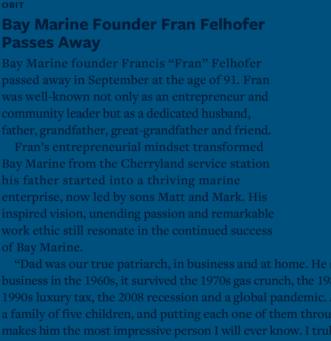

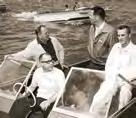
“Dad was our true patriarch, in business and at home. He started his own business in the 1960s, it survived the 1970s gas crunch, the 1980s recession, the 1990s luxury tax, the 2008 recession and a global pandemic. All while raising a family of five children, and putting each one of them through college. That makes him the most impressive person I will ever know. I truly believe that my father might be the smartest person I will ever know,” says Mark Felhofer.

In lieu of flowers, donations may be made in Fran’s name to the Door County YMCA or the Door County Maritime Museum.

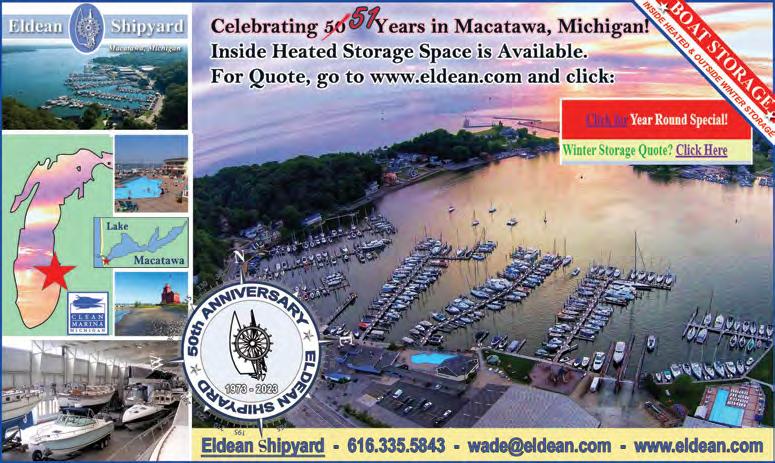
By Capt. Frank Lanier
Getting the most from your test drive before buying a boat.
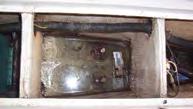

Atest drive is a great way to narrow down a list of potential boats before spending money on a marine survey. Sure, you could ride around with a margarita in one hand while the broker regales you with tales of faraway lands, but a smarter move would be to approach your test drive with planning and a critical eye. Here’s how to glean as much info as possible about your potential purchase during a test drive.
A test drive is typically shorter than a formal sea trial, so you may not have time to do all of the tips below. Concentrate on the ones you feel will yield the most information in the amount of time you have. If you’re not 100% confident in your ability to do any of them, just leave those for your surveyor to conduct during an official sea trial.
Leave the kids and dogs at home
Approach your test drive as a fact-finding mission, not a joy ride. Restrict your guest list to those with an immediate interest in the boat-buying decision.

Ask the owner or broker not to start the engine before you get there. You can learn a lot from a cold start, but the most basic observation is how hard the engine is to start — a perfect time for weak batteries and other such problems to make themselves known. Arrive a bit early if possible, allowing for additional time to familiarize yourself with the boat. Check the bilges (bilge water level, presence of oily water, etc.) and compare that with how the bilges look once you’ve returned to the dock. Check the engine oil and coolant levels, as well as the transmission oil level before and after the trip, confirming correct fill levels and noting any changes that could indicate leaks. It’s good to check fluid levels for hydraulic steering systems and trim tab units as well, if applicable. If there’s a generator, check oil and coolant levels and ask that it be started at the beginning of the test drive and placed under load (powering the air conditioning for example). Let it run for the duration. Place a clean drip cloth under the engine and generator before getting underway (which makes oil leaks more noticeable) and record engine and generator hours before and after your test drive to verify the hour meters work.
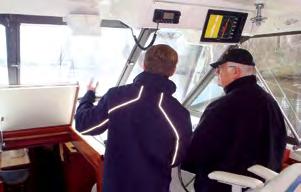
Discuss any boat maneuvers you’d like the captain to do during the test drive before leaving the dock. Once underway, record the oil pressure, coolant temperature, volts and gearbox oil pressure for the engine at various speeds (slow throttle, half, full and cruising speed). Record these at all helm stations to compare readings and verify the gauges work and that the readings match.
While underway, inspect stuffing boxes, dripless shaft seals and rudder glands for leaks. It’s not unusual for these to be dry at the dock but leak while the vessel is underway.
Check the shaft for vibration at various speeds. If there’s a visible wobble, you can get a rough idea of how bad the problem is by touching the top of the gearbox. If you can feel it there as well, the issue needs to be corrected sooner rather than later.
Note the engine’s maximum RPM (this is typically displayed on the data tag) and once warmed up, ask that it be run at full throttle for a short distance. The RPM at wide-open throttle should be within 100 or so of that stated.
While running at maximum speed, verify that the actual speed matches the advertised speed. This is also the time to look for any unusual sights and sounds: Burning smells, smoke, vibration, excessive broker sweating, etc.
Standard maneuvers while under power include a back-down test and a figure-eight turn. The back-down test (reducing throttle quickly while shifting from cruising speed to neutral, then to reverse, then increasing power) lets you check the engine mounts for excessive movement. Worn or misaligned engine mounts cause shaft alignment problems, meaning the mounts themselves may be bad or due for replacement soon. Figure-eight turns at cruising speeds are useful to verify maneuverability, handling and that the vessel has an equal turning radius to port and starboard.
There are plenty of things you can do to make a test drive productive, but that doesn’t mean you can’t have a good time as well. You can still listen to the raucous tales of the owner or broker — just tell them to hold off on the margaritas until after your work is done.

By Glenn Hayes
Five gift ideas for the tech-savvy boaters in your life.
t’s that time of year again to start thinking about gifts for the boaters in your life. The good news is there are lots of offerings out there, even for the boater who has it all. Let’s look at some ideas to fill that holiday gift list.
In an affordable, complete package, fishermen can now take advantage of live sonar imaging to find and catch more fish than ever. The Lowrance Eagle Eye sonar system comprises a crisp and easily seen 9-inch enhanced IPS display screen that can be viewed at any angle and with polarized sunglasses. Coupled with an all-in-one live view transducer, this fishfinder can display autotuning live sonar with focused down and forward views. It even has the exclusive FishReveal mode, which helps identify fish from the structure. The built-in chartpotter takes full advantage of detailed C-Map charting and features the Genesis Live custom charting. $999 at LOWRANCE.COM
Having your phone accessible and in view while aboard can sometimes be tricky. Enter the Scanstrut Nano wireless charging mount. This tiny, self-contained wireless charger will fit into the most cramped console or helm and can be mounted in any orientation. Its design is simple, it can be mounted almost anywhere and it provides 10-watt charging to any compatible smartphone through a simple 12-volt connection. The strong side clamps hold the phone firmly, and the base plate charges the phone while in place. The company offers other wireless charging options and mounts, so if this model mount doesn’t work for your application, others will. $119.99 at SCANSTRUT.COM
Simrad recently introduced one of the most advanced trolling motors on the market, the Recon. This tech-filled trolling motor can be used in fresh and saltwater and features a highly accurate GPS that can anchor and lock your boat into a specific position and hold you there with no anchor needed. The silent brushless motor will get you onto fish without spooking them, and the wireless remote with a built-in joystick

control will get your boat where you need it quickly and silently. The integrated sonar technology works seamlessly with many newer Simrad and Lowrance displays, producing high-resolution sonar images. Available in 48-, 54-, 60- and 72-inch shaft lengths, these trolling motors can be mounted on a wide array of boats. Starting at $3,299 at SIMRADYACHTING.COM
Give the gift of safety and peace of mind with the ACR ResQLink AIS PLB. This personal locator beacon registers to an individual rather than a vessel so it can be taken from boat to boat. It can even be used in remote areas without cell coverage in a non-boating environment. When the manual switch is triggered, this beacon transmits an emergency signal via satellite to emergency services with the beacon’s registration number and location. Unlike other PLBs, it will also transmit an AIS (Automatic Identification System) signal that can be seen by commercial and recreational vessels nearby, indicating to them that there is an emergency; those vessels can quickly respond to the emergency, locating it on their navigation screens. The ResQLink AIS also has NFC capability that, when linked to a smartphone, will notify the user that emergency services have received their emergency signal and help is on the way. $569.95 (not including subscription costs) at ACRARTEX.COM
Many of us like to use an action camera to capture all the fun we have aboard. Selfie sticks can be problematic aboard, but SeaSucker offers a simple solution. Specializing in heavy-duty suction cup-mounted accessories, SeaSucker now has an action camera mount capable of mounting small cameras, such as a GoPro, securely on any non-porous flat surface. With a 4.5-inch vacuum-mount suction cup that pumps up the suction, allowing for an incredible 120 pounds of holding power, these camera mounts will not shift or move even in the roughest seas. Easy to remove and place in all kinds of locations, cameras are mounted via an industry-standard fingered anodized aluminum tripod mount. There are also versions with a 7-inch heavy-duty gooseneck to get the perfect angle. Prices range from $65 to $79 at SEASUCKER.COM


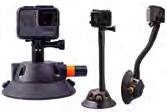


By Heather Steinberger
For 25 years, the U.S. Coast Guard has delivered Christmas trees to Chicago families in memory of the Rouse Simmons.
If you grew up in the Great Lakes, you are likely familiar with a ship that sank in 1912 — no, not that one.
Seven months after the Titanic met an iceberg in the North Atlantic, th e three-masted schooner Rouse Simmons was lost with all hands in Lake Michigan. She went down off Two Rivers, Wisconsin, during a vicious storm on November 23, 1912.
Why do we remember this particular schooner when Lake Michigan has claimed many hundreds of ships?
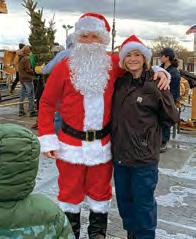
The Rouse Simmons was special — she was the “Christmas Tree Ship.” When she foundered, she carried 5,500 pounds of Christmas trees to the bottom of the lake instead of to the families awaiting her in Chicago.
Despite the tragedy, Capt. Herman Schuenemann’s family kept the holiday spirit burning bright. His widow, Barbara, took up the mantle, selling trees until she passed away in 1933; her daughter carried on for several years after that.
Three generations of Schuenemanns pursued their heartfelt mission for six decades, deeply affecting the city of Chicago and the Upper Michigan communities of Thompson and Manistique, where Capt. Schuenemann and his older brother, August, first started harvesting evergreen trees in the 1870s and ’80s.
Their story remains a treasured one in this corner of the Upper Midwest, and thanks to the U.S. Coast Guard Cutter Mackinaw, their legacy on Lake Michigan endures.

Every December for the last quarter century, the ship loads Christmas trees in northern Michigan and delivers them to Chicago families in need.
This year is the 25th anniversary of the contemporary Chicago Christmas Ship. The Mackinaw will arrive in the city on Friday, December 6, 2024, and the Chicago Yacht Club will welcome VIPs, invited guests and tree donors to a reception from 6 to 9 p.m.
The public is invited to watch the main event on
Saturday, December 7. Tree offloading will begin at 8:30 a.m., and the ceremony will begin at 10 a.m.
Chicago’s Christmas Ship is the city’s largest allvolunteer charitable support program for inner-city youth and their families during the holidays, with nearly 50 participating organizations. These include the U.S. Coast Guard and Ada S. McKinley Social Services, which selects the families that will receive trees.
“It’s such a team effort,” says Jeannette Greene, Mackinaw’s commanding officer. “We’re doing this to honor the Schuenemanns, pay tribute to a beloved story, and benefit the people in Chicago.”
Greene explains that 1,200 trees are purchased with donated funds from a farm in the U.P., which then travel aboard a decorated semi-truck to the Mackinaw’s home port of Cheboygan, Michigan. There, volunteers gather to load the trees.
“We usually load right after Thanksgiving, which is fun,” Greene says. “Schools like to help out as well, so we’ll have crew, families and kids all working together, and everyone has so much holiday cheer.”
The volunteers carefully load the trees on the Mackinaw’s fantail rather than on her main deck. This is intentional, Greene says, since the ship has a very different design to that of her predecessor.
As boat nerds know, the original USCGC Mackinaw was decommissioned in 2006 after 62 years of service. She was a full-time icebreaker, which meant the trees could be stored anywhere on deck.
The current Mackinaw, however, does double duty as an icebreaker and buoy tender. For several weeks in November and December, her crew pulls out Lake Michigan’s large buoys with the optical and sound features that ice can destroy; they replace them with smaller, ice-capable versions or nothing at all.
“We’re racing winter,” Greene says. “We have to keep the buoy deck free so we can continue our work; as soon as the Christmas tree event is over, we have to get back out there. Then, in the spring, we’ll put the big buoys back. It’s dangerous work. We need to always have our game faces on.
“When I think about the Schuenemanns’ old 123-foot wooden schooner carrying all that weight in terrible weather, with icing, I realize how far we’ve come,” she continues. “The Mackinaw is 240 feet long and 58 feet wide, so we’re very stable, and we’re built tough to handle these conditions.”

Greene started her career in 2005 as part of the commissioning crew for the current Mackinaw, when the ship was still under construction at Marinette Marine in Marinette, Wisconsin (then a subsidiary of Manitowoc Marine Group, the shipyard today is part of Fincantieri Marine Group). She became commanding officer in 2022.
“I love this ship,” she says. “Naval architects used to make icebreakers as heavy as they could, with a football-shaped hull. This is so different.”
Mackinaw’s propulsion system incorporates two Azipods and a bow thruster, unique for the military. The system allows the ship to push a large amount of water in any direction.
“It’s a great tool, especially when we have to provide direct assistance to a vessel in hard water,” Greene explains. “We can relieve the pressure that holds a ship in place.”
An old-school icebreaker rises up on the ice and punches through it, creating a narrow, straight path through the ice. In contrast, the Mackinaw’s Azipods are designed to move the water that holds the ice up; they push the water aft and out, creating a much wider path that allows ships to keep moving.
“This ship is incredibly maneuverable with a dynamic positioning system,” Greene says. “A really smart computer talks to our propulsion system, which allows us to come within feet of a latitudelongitude point and stay in one spot.”
In icebreaking work, she observes, it’s often most effective for the Mackinaw to approach stern first. In that case, the ship’s aft bridge comes in handy.
“We will back up crazy close to the laker and push the water back and forth,” she says. “It’s like a big Jacuzzi. The ice collapses on itself.”
A tribute to the Schuenemanns
Greene clearly loves her work. She and her crew are responsible for keeping waterways open and freeing the massive lake freighters that haul lime, gravel,
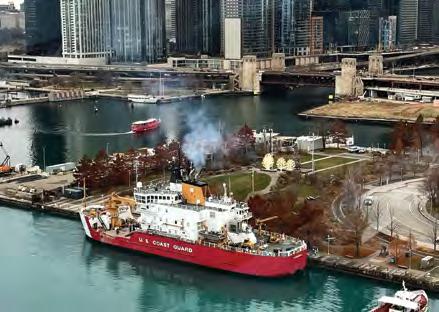
taconite and other raw materials that keep the wheels of the regional economy turning.
Great Lakes residents and visitors get attached to these lakers. Greene says she and her crew are no different; they also feel drawn to the big ships’ history and lore.
“We fangirl too,” she says with a laugh. “We wave. We blast the Great Lakes salute. We get it.”
Without question, that joy extends to the Mackinaw’s Christmas tree run. All sailors relish a port call, and this December, Greene and her crew will get a brief but much-needed break.
“It’s a fun city,” Greene says of Chicago. “We’re looking forward to delivering the trees, giving tours and meeting people.”
Through it all, they will remember the Rouse Simmons. In fact, each year on the way to Chicago, the Mackinaw travels over the schooner’s final resting place and drops a wreath.
“We want to connect to them, and to reflect,” Greene says.
Then they will carry on to Chicago, where they will be greeted by a scene that Capt. Schuenemann would have recognized.
“I guess the kids are gladdest of anyone to see us come pulling into the river every December,” he remarked to the Chicago Inter-Ocean in 1909. “There’s generally a crowd of children… they wave their hands and cheer, and we cheer back. Some of them think we are actually coming from the North Pole.”
Chicago erected its first city Christmas tree in tribute to the Schuenemanns, and more than 100,000 people paid their respects at the Christmas Eve tree lighting ceremony in 1913. Greene says it is an honor to play a role in keeping the family’s memory alive more than a century later.
“We are so grateful to be able to do this,” she says. “To the families of Chicago, and families everywhere, ‘Ho! Ho! Ho!’ from the crew of the Mackinaw!”
To learn more about Chicago’s Christmas Tree Ship, including how you can become a tree donor, visit CHRISTMASSHIP.ORG.
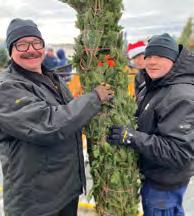

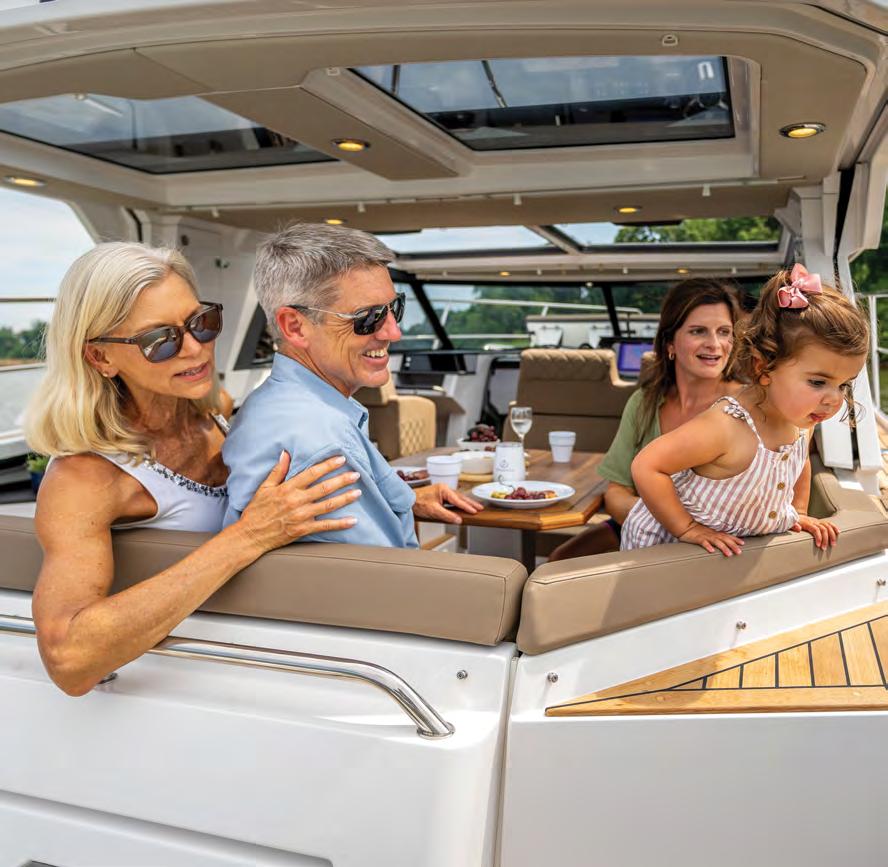



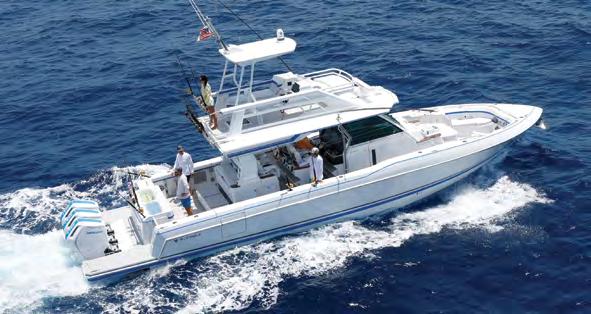
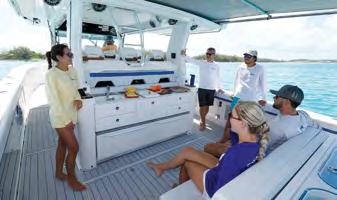
THE FORMULA 457 CENTER CONSOLE FISH will be your offshore adventure destination. The 457 Center Console Fish and Sport models push the boundaries of design, engineering and construction in the offshore center console world, celebrating the finish and amenities of Formula’s renewed entry into the center console market.
e 457 CCF is a dedicated and designed fish hunter, shaped and equipped to haul in your catch. With a 45-foot, 7-inch LOA, a 13-foot, 9-inch beam, and powered by triple Mercury Verado 600-hp engines, the Formula 457 will impress all comers.


Accented with multicolored LED lighting, a center ladder and an access hatch, the hardtop features an impressive compound curved windshield with power-opening forward glass and washer/wiper combo. Custom-designed triple helm seats feature individual sit/stand/rest positions, electrically adjusting fore and aft, and foldaway armrests. The captain and crew enjoy a standard 18,000 BTU air conditioning system plus an impressive electronics suite, including twin 22-inch Raymarine or Garmin widescreen color chartplotters, Mercury Joystick Piloting and Bennett trim tab system.
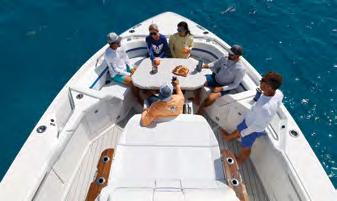
e impressive mid station brings a trove of innovations with an aft-facing mezzanine bench that slides away to reveal a full Corian countertop and a molded sink. e rigging station/wetbar features the Plano tackle box station, a deep drawer storage and a dedicated fishing locker to port. e open bow features dual forward-facing sun lounges with outer armrests.

Fishing features abound on the 457 CCF, with dual 50-gallon, pressurized livewells aft, which also secure eight dive tanks, port and starboard fishboxes with macerators, and in-floor storage with YETI buckets. Boaters have the option to add an upper helm station on the CCF. Under its own hardtop, the upper helm station gives the captain improved vantage and control.
Entering through the portside console door, head below to the cabin to find a U-shaped lounge/double berth, a galley with Corian countertop, stainless pull-out fridge and microwave. A molded private head compartment with a separate stall shower and Vacuflush head makes for an easy all-day and overnight adventure! e aggressive yet reliable 22-degree deadrise FAS³TECH hull anchors the handling of this Formula-bred offshore performer, delivering speeds up to 60 mph.



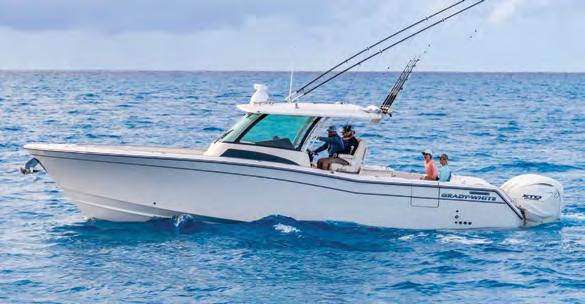

GRADY-WHITE’S RUGGEDLY luxurious Canyon 386 combines the celebrated SeaV hull with top-of-the-line features to deliver the ultimate boat. With a perfect balance of fishability and noteworthy cruising features, the 386 design results in a versatile boat packed with style, performance and more creature comforts than other center consoles of its size.
e Canyon 386 perfectly melds some of the best design features of Grady-White’s flagship Canyon 456 with the historic success of the Canyon 376 to deliver the highest in boating satisfaction. An extra-wide beam (13 feet, 2 inches) yields added square footage resulting in abundant space for four adjustable deluxe helm chairs under the AV 2 hardtop and behind the full-height wraparound windshield — providing all-day comfort and protection from the elements. e vergonomic design of the sleek black helm boasts a large flush-mount electronics area, push-button switches and full maneuverability controls for the triple Yamaha 450 XTO engines.


e wider beam also creates a spacious console interior, including a full galley with a microwave, a cherry dinette table that converts into a berth, and a separate enclosed head with

a sink, porcelain head and a stand-up shower. Other notable features of the console include air conditioning, natural lighting, plenty of storage, including space for eight rods, and a standard 24-inch TV. Whether overnighting at the canyons or enjoying a romantic weekend to a favorite seaside town, the 386 is perfectly situated for comfort.
Anglers will appreciate the sizable cockpit with a 291-quart insulated refrigerator/freezer fishbox, dual 35-gallon livewells, and a lean bar with rod holders, knife and plier holders, and a Corian countertop. When cruising is the activity of choice, the rigging station easily converts into an entertainment zone, complete with a freshwater sink and an optional grill. e bow also lends itself to hosting a crowd with a plush console lounge with folding armrests, electromechanically adjustable backrests on the port and starboard seats, a sizeable casting platform with cushions, and an optional electrically adjustable table. Additional standard features that make this boat a standout include a Seakeeper 4.5 gyro stabilizer and Sureshade. When it comes to rugged durability and luxury, the 386 proves you really can have it all!
GRADY-WHITE gradywhite.com



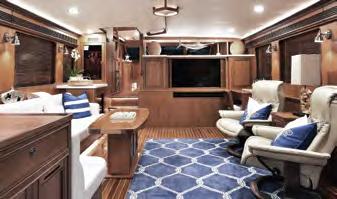
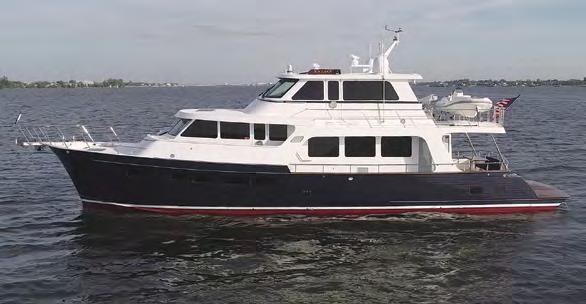

MARLOW YACHTS, a leading innovator in the marine industry for over two decades, has redefined yacht manufacturing with advanced research, refinement and rethinking of the yachting experience. rough its innovation, design and testing of advanced materials and technology, Marlow Yachts has pushed the boundaries of craftsmanship, materials science and seaworthiness throughout the entire line of Marlow Explorers (53E to 88E) and Marlow Voyagers (76V to 100V). e Marlow Explorer 66E-CB is pictured above. When the yacht is a Marlow, the expectations are high! e hull and interior bulkhead designs utilize the finest engineering principles employed by the aviation and marine industries to create the maximum interior volume, comfort and performance under all conditions. Most of the components in Marlow yachts begin in the shipyard as raw plate, tube and billet of the highest specification and quality. Each yacht’s wood components are made from whole logs, hand-selected and processed in workshops in the shipyard. Interior finishes as unique as each owner are created by highly skilled craftsmen in composite construction techniques, metalwork, joinery and stonework. e final product is a yacht of unparalleled beauty, performance,


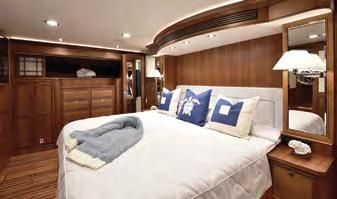
and seaworthiness with an exceptional resale record significantly higher than other brands.
Marlow Explorers are constructed with a proprietary Strut Keel designed to protect vital running gear from grounding or debris damage. e twin struts, combined with a semi-displacement hull, provide superior tracking, positive fuel efficiency and impressive cruising comfort regardless of conditions. e extensive use of Kevlar, carbon fiber, Corecell and specifically engineered reinforcement fabrics with proprietary resins and Full-Stack Infusion process produces an inherently stronger and more durable hull. Another Marlow hallmark is all engine rooms are full height across the entire line of yachts and can be air-conditioned, enabling easier access and greater comfort for general maintenance tasks.
To own your first Marlow is to know why Marlow says words are inadequate. Designed and built to explore your world and passions, be it the Great Loop, the Bahamas or the many other cruising adventures obtainable utilizing her long-range cruising capabilities, your adventure awaits! Arrive at your yachting destination in a Marlow and you will completely understand why a “Marlow is the envy of the yachting world!”
MARLOW YACHTS marlowyachts.com




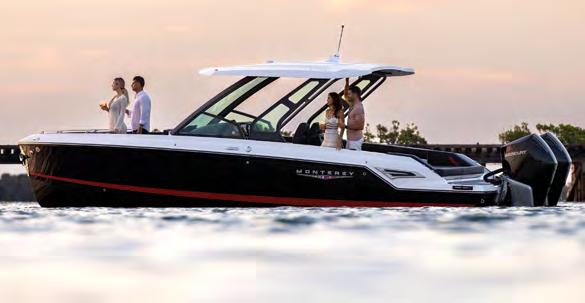
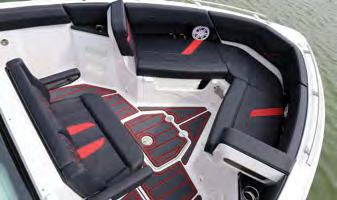
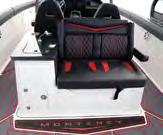
THE ELITE 30 from Monterey Boats is a remarkable blend of luxury, performance and innovation, catering to boaters who demand the best on the water. Designed for those seeking style and substance, the Elite 30 provides unmatched comfort, advanced technology and outstanding versatility, making it the perfect choice for everything from adrenaline-fueled watersports to leisurely cruises or gatherings with loved ones.


The Elite 30 stands out with its contemporary design, featuring clean lines and high-quality finishes that exude sophistication. Whether docked or cruising, this boat makes a striking impression on the water.
Every inch of the Elite 30 has been carefully crafted to maximize space and comfort. Ample seating throughout the boat ensures there’s plenty of room for everyone to relax and enjoy the ride. e port and starboard helm seats come with flip-up thighrise bolsters and slides, providing comfort and maneuverability. Additional seating options include an aft-facing cockpit seat, a sunpad with articulating backrests, and roomy bow
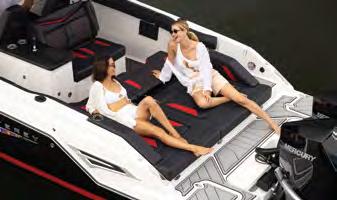
seating. e boat also includes a large head compartment for added convenience. e Elite 30 is packed with the latest marine technology, including a Simrad 15-inch UltraWide multifunction display at the helm, offering intuitive navigation and control through the CZone digital switching system. Premium audio systems elevate your on-water experience, providing rich, clear sound for your adventures.
Engineered with Monterey’s Vertical Stem Technology, the Elite 30 effortlessly cuts through water and waves, delivering a smooth, dry ride. Its 21-degree hull deadrise at the transom ensures a stable ride, even in challenging conditions. e boat’s powerful engines and superior handling provide a responsive, thrilling experience.
e Elite 30 is designed for entertainment, featuring a cockpit wet bar with a solid surface countertop, sink and trash receptacle. A versatile table can be set up in both the bow and aft areas, and ample storage ensures all your essentials are easily accessible.
In every way, the Elite 30 exemplifies Monterey Boats’ dedication to delivering an elite boating experience.
MONTEREY
montereyboats.com




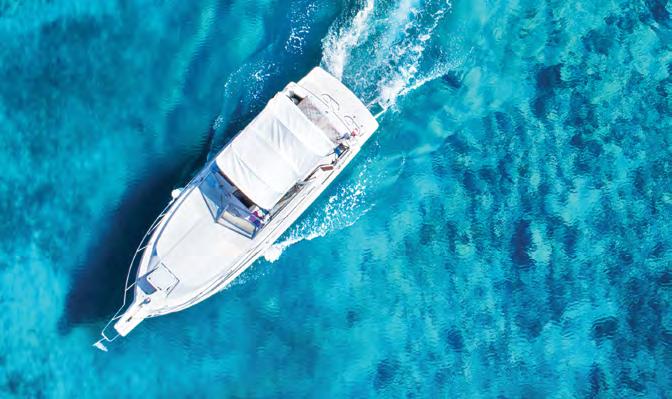
THE WATER IS AN EXCELLENT PLACE to escape to — it’s generally peaceful and inviting. But what if the unthinkable happens: You collide with another boat, or hit someone’s wake and your passenger is injured?
“Boat insurance might not be topof-mind when you purchase a boat or personal watercraft, but it should be,” says Rick Stern, boat product manager at Progressive Insurance. “No matter the size or value of your boat, it’s important to be covered. Accidents happen, and when they do, our customers are glad that they had insurance.”


Whether or not they’re aware, boaters who remain uninsured are choosing to pay for any damage or injuries related to their boat and passengers out-of-pocket. Sometimes those who opt to not have insurance have a relatively inexpensive watercraft and may figure they’ll take the financial hit if their watercraft sinks or is stolen. No big deal, right? But, say their 16-footer sinks at someone’s dock; it can cost hundreds or thousands of dollars to refloat and remove it. Or if your boat breaks loose from its dock and drifts into your neighbor’s wakeboat? e cost to repair your neighbor’s boat might run into the thousands of dollars, and you may be personally liable for that cost if you don’t have insurance.

Another factor to consider is personal injury liability. Boat liability insurance means you’re protected from accidents that injure someone on your boat or another boat. Without insurance, these situations may put the boater and their loved ones at financial risk.


If your boat is struck by an uninsured watercraft, injuring you or your passengers, all parties may be on their own and accountable for medical costs unless you have a boat insurance policy with Uninsured Boater coverage. Uninsured Boater coverage is designed to cover injuries caused to you and your passengers by an uninsured boater.
These unexpected scenarios are seen far too often. By purchasing a boat insurance policy that includes Liability and Uninsured Boater coverage, you’re protected from the financial burdens of these incidents. e cost? Coverage at Progressive can be had for as little as $100 per year!
Progressive Insurance insures more than 1 million watercraft. To learn more about Progressive’s Boat Insurance, visit PROGRESSIVE.COM/BOAT or call 855-347-3939.



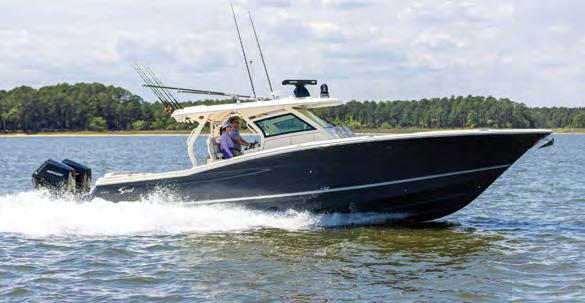

THE 400 LXF LI-ION is a new model from Scout and an alternative version to the current 400 LXF, complete with a lithium-ion battery management system (no generator necessary). The Mercury engines also charge the batteries. Scout’s S-Class (luxury models 33 feet and up) designation signifies the upper echelon of the brand’s lineup, similar to what you experience with high-end luxury automobiles.

The 400 LXF Li-Ion is meticulously crafted with the highest-performing dual Scout stepped hull technology and the finest blend of appointments and technologies. e 400 LXF Li-Ion is manufactured with cutting-edge carbon epoxy construction and is loaded with standard features such as the standard Seakeeper gyro stabilizer.
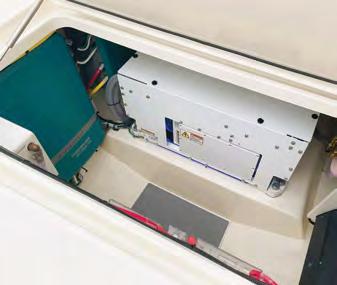

Options like the patented electronically actuated articulating rocket launchers and the convertible leaning post with a Kenyon grill, sink and cutting board further distance this model from anything else in its class. e standard hydraulic portside beach platform with synthetic teak adds to the model’s characteristics, making it not just an incredible boat, but an incredible experience. SCOUT BOATS
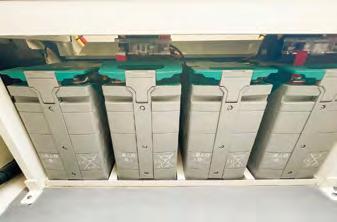





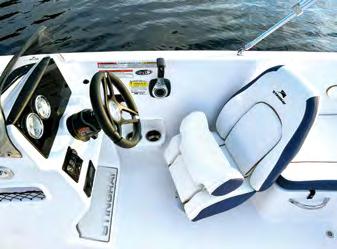
IT’S TIME TO WELCOME aboard Stingray’s newest addition, the 172DC Dual Console. Joining the fleet as the sixth model in its Dual Console lineup, the 172 DC will take you along for an unforgettable ride. With plenty of bow seating and room to stretch out, this boat quickly becomes a hangout spot, with cup holders and storage space for the whole crew.


All Stingray models utilize the exclusive Z-Plane hull design and the new 172DC is no exception. e Z-Plane hull has a notched transom adopted from offshore racing boats, which allows the drive to be mounted higher to reduce drag and increase performance. Z-planes act as horizontal planing faces when submerged, and when very near the water’s surface, the outside edge of the Z-plane acts as a spray release. is revolutionary design passes through the water with no bubbles or vortices formed by the hull shape. e smooth flow of water
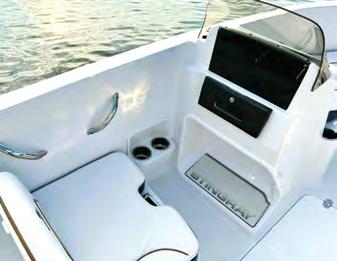
generated by this design allows the propeller a better bite during both straight-line speed and hard-cornering maneuvers. e 172 DC comes standard with a dual windshield, two fishing rod holders and four fusion speakers to ensure your Stingray is always the life of the party. Stingray has always prioritized comfort and ease, and the new 172 DC is no exception. is model includes optional features such as a removable bow filler seat cushion, a cooler and a Bimini top to escape the elements. e 172 DC lives up to the Stingray standard of innovative excellence, performance and efficiency.
STINGRAY BOATS
stingrayboats.com




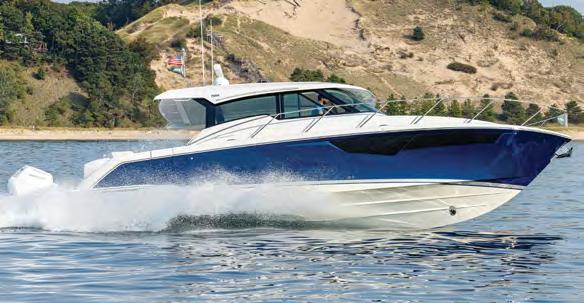
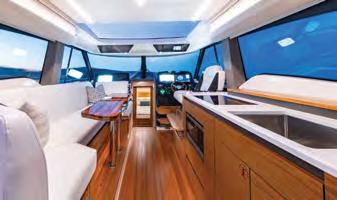
REIMAGINED AND REDEFINED, the updated Tiara Yachts 43 LE offers refined interior amenities alongside an updated aft cockpit. A glass enclosure with a sliding door and an electrically actuated window open seamlessly to the cockpit, complete with a folddown hullside terrace. Opposite the hullside terrace, a side boarding door offers easy access from a floating dock. Choose between the Buffet Lounge or Adventure Module to tailor the cockpit to your boating preferences.


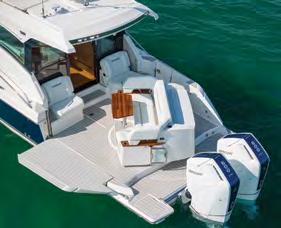
e rotating Buffet Lounge features a high-gloss table, an electric grill and a countertop, while the Adventure Module includes folddown lounge seating, a coil-wrapped freezer tank, a livewell and other fishing amenities needed for a memorable day on the water. e fully equipped and centralized galley in the salon is complemented by the transforming portside companion seat
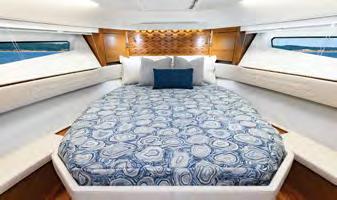
that adjusts to unveil additional dining seating around a highgloss teak table. e table also adjusts to convert into a berth and provides additional sleeping accommodations. A salon TV is mounted in the starboard galley on a hi-low actuator and can be concealed when not in use.

Head below deck, where you are welcomed into the atrium. A private owner’s stateroom is located forward while a mid-cabin guest stateroom and private head accent the space.
Paired with twin Mercury 600-hp V12 engines, the 43 LE is built for performance. e integrated electronics package includes Mercury digital throttle and shift alongside joystick piloting. Garmin Marine navigation systems complement the Mercury package and are intuitive for the captain when exploring port to port.
TIARA YACHTS tiarayachts.com



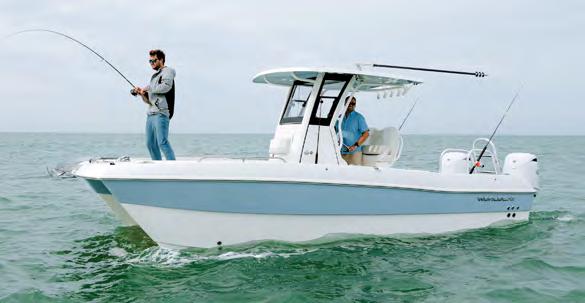
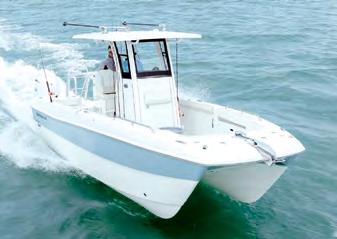
THE 235TE is the seventh model in World Cat’s center console lineup. is 22-foot, 7-inch model is the Tournament Edition of the World Cat fan favorite, the 235CC Center Console. Designed with fishing in mind, this all-new model features standard port and starboard 150-quart insulated floor fishboxes with an overboard discharge pump aft, four gunwale-mounted stainless steel rod holders, a freshwater shower in the transom, a commercial-grade dive ladder and swim platform, a saltwater washdown, four forward gunwale-mounted rod/cup holders, and a flip-up bolster leaning post with rocket launchers, tackle drawer and a 45-quart Yeti cooler with a seat cushion. Also standard on the 235TE are the unique fold-down port and starboard forward bench seats, allowing for more casting room in the bow without eliminating seating opportunities for the crew.


e 235TE also boasts a max horsepower of 300 hp (twin 150-hp engines) and a draft of 9 inches, allowing customers to fish inshore while having the performance, stability and safety offshore that World Cat models are known for.
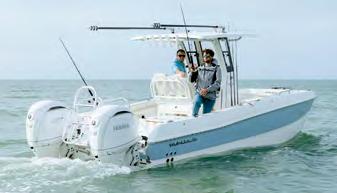


Optional features on the 235TE include four quick-release fender holders, a deck-mounted windlass with rode, chain and anchor, a porta-potti with deck pump-out, an additional Yeti 45-quart cooler with a cushion for the aft cockpit or forwardconsole seating, an onboard battery charger and a Gemlux deluxe outrigger system with 18-foot collapsible hybrid poles.
By Charles Plueddeman

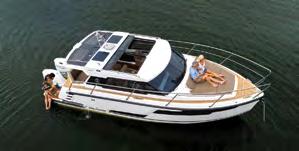


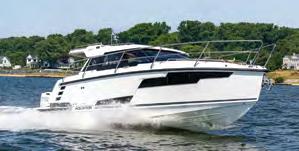
IN THE EARLY 1960S,


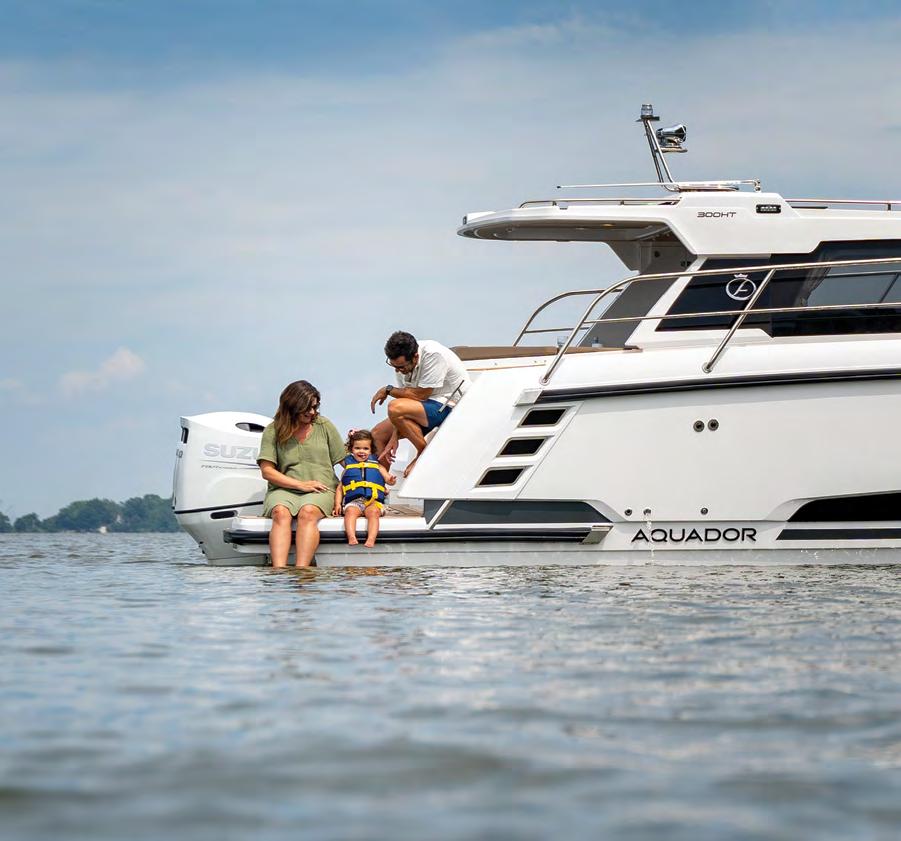
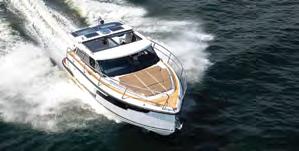
the “British Invasion” changed the sound of pop music in America. Today, an invasion of Scandinavian designs is changing the look of pleasure boats on our waters.
This latest “invader,” the Aquador 300 Hard Top (HT), originates from Finland and sports the near-plumb stem — a ubiquitous feature of designs from Northern Europe like Saxdor, BRABUS, Fjord, Jeanneau, Axopar and Nimbus. This look is now migrating to American brands, from the Euro influence of Groupe Beneteau on the Wellcraft nameplate to the latest models from Bayliner and Monterey.
Our afternoon on the waters of Lake Michigan proved there is more than a plumb stem to the Aquador 300 HT. This is a family cruiser loaded with many great design details.



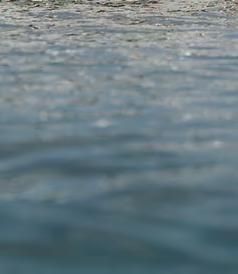

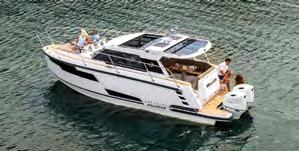
The 32-foot, 9-inch 300 HT model was launched by Bella Boats under its Aquador brand in 2022. Since 2018, Bella Boats has been part of the Nimbus Group, based in Sweden. Aquador currently offers the 300 HT and the 25-foot 250 HT model, which are now both available in North America through a distributor agreement with the franchised fractional membership organization PowerTime Boat Club. Aquador boats will be sold into PowerTime fleets for shared usage and will also be offered to retail buyers, with PowerTime acting as the dealer and a local franchisee handling service. The Aquador 300 HT we tested in September is the first boat available through PowerTime Door County in Sturgeon Bay, Wisconsin.



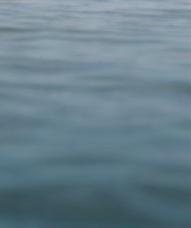





SPECIFICATIONS
LOA: 32'9"
Beam: 10'6"
Dry Weight: 9,921 lbs.
Fuel Capacity: 125 gals.
Water Capacity: 37.5 gals.
Power (as tested): 2 X Suzuki DF200 outboards
Price (as tested): $376,645
AQUADORBOATS.FI

PowerTime Boating
Chicago, IL; Door County, WI; Milwaukee, WI
POWERTIMEBOATING.COM
�
� WATCH THE VIDEO AT LAKELANDBOATING.COM
Generous headroom below decks, with a mid-cabin designed for adult comfort
Cockpit is bright and airy thanks to glass panels in the hardtop, yet easy to button up for foul weather
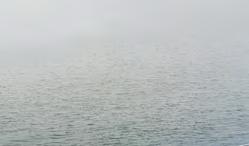
Excellent access to batteries and fittings in the bilge



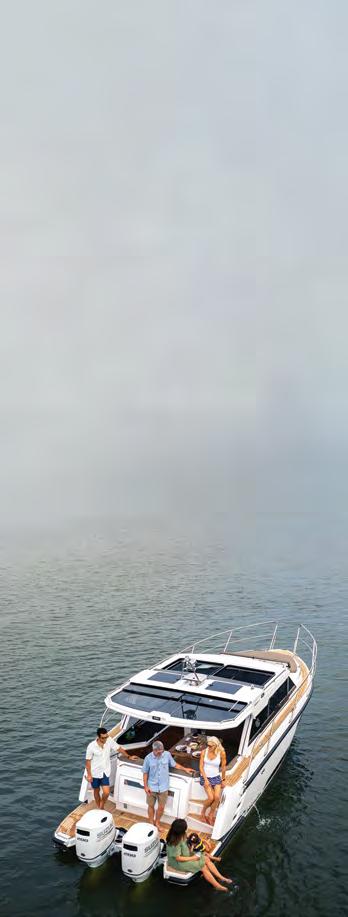
Designed from the inside out Aquador says the 300 HT model was designed from the inside out, so we began our walkthrough from the cabin. Headroom is excellent at about 6 feet, 1 inch throughout the cabin with full-length sidelights and a large overhead hatch providing plenty of daylight. Woodwork in the cabin is all beautifully finished walnut. There’s a settee to port that extends below the berth so that it can double as a child’s bunk, and a space on the forward bulkhead is intended for an owner-installed flat-screen TV. The V-berth is 6 feet, 4 inches long — clearly this is a cabin designed to accommodate tall adults in comfort. A walk-in head features a glass bowl sink, a flushing commode, a hand-held shower, a sidelight with port and a cabinet below the sink. Just abaft the head is a private mid-cabin with a settee, a closet and a full-size berth. Headroom here is also more than 6 feet, and a sidelight emits lots of daylight. This could be a very comfortable living space for weekending with family or two couples.
The cockpit of the 300 HT is designed to be a welcoming social space. The standard hardtop extends aft to shade the entire area, but large side windows and four glass panels in the top keep the space very bright and airy when that’s desired. The two forward glass panels open and all are fitted with pull-out sunshades. A bench seat surrounds a central teak table with a folding top. The table can be raised or lowered on an electric pedestal; when in its low position, it can be covered with cushions to create a third berth.
The galley is to port, and our test boat was equipped a sink and a two-burner convection range powered by diesel fuel. When not in use, both the sink and range may be covered by a hinged hard surface to form a wide countertop. An 85-liter slide-out refrigerator is located below the sink, with abundant storage in drawers and cabinets. There is no microwave on the boat. Our boat
featured heat and AC for the cabin and cockpit. The entire cockpit can be enclosed by sliding clear curtains out of the aft sail panels and securing them together with a center zipper.
The helm is elevated from the cockpit sole, which creates that excellent headroom in the mid-cabin below but makes for rather tight headroom at the wheel. You’ll sit at the controls — unless you open the glass panel overhead, which allows almost any adult to stand at the wheel and look out above the hardtop. This is actually fun when the weather is nice and affords excellent visibility around the dock.
Helm features include a pair of 12-inch Simrad NXT displays plus smaller Suzuki displays for each engine, an optional joystick for the Suzuki engines, a display to monitor the solar-power charging system, a joystick for the bow thruster, a control for Zipwake interceptors and a Simrad VHF. A covered stowage compartment on the dash top features two wireless device chargers.
Passage to the bow is via port and starboard walkways accessed up steps from the transom platform. Each is only 7 inches wide, but a full-length railing and grabrails on the hardtop help steady the way. Our boat had an optional sunpad over the cabin top. Eco Teak covers the rest of the foredeck, walkways, the transom platform and the cockpit sole. Synthetic decks are also available. The transom platform extends more than 4 feet outboard the motors with 20 inches of walking space forward the outboards. With sterndrive power, you’d get the full, uncluttered platform with sockets for a small table and a fold-down seat from the transom. With outboard power, a large dunnage box is built into the transom with room for wet lines and fenders. The entire aft cockpit sole lifts open on an electric strut; because there is no engine below, much of that space can be used for stowage, and there’s a molded tray to keep gear out of the bilge. Lift out that tray for excellent access
to all systems and fittings, including a pair of Relion RB300 300-amp hour LiFe house batteries, which can be charged by shore power or a pair of 55-watt solar panels on the hardtop through a MasterVolt battery management system.
Handling and performance
Our test boat was powered by a pair of Suzuki DF200 outboards. A pair of Mercury Verado 200 outboards are also a power option, as is a single 320-hp diesel Volvo Penta D4-DPI Aquamatic sterndrive. The 300 HT has a beam of 10 feet, 6 inches and a displacement of just under 10,000 pounds. These power options might seem a bit modest by American standards but are typical for Europe where fuel costs are much higher.
After waiting for a bridge to open, we took a quick run east toward Green Bay. The Aquador Aquadynamic running surface has a rather flat 18-degree deadrise at the transom but still delivered a smooth ride over a brisk chop. To create the spacious cabin, the boat has a rather chunky profile with very high freeboard, plus the hardtop, and the rather flat bottom likely improves stability at rest. The 300 HT heels way over in a hard turn but tracks well. Gyro stabilizers are also available as an option. With a light load of gear and passengers, we recorded a top speed of 39.4 mph (34.2 knots) and a 0-to-20 mph time of about 12 seconds. Economy was excellent at 1.5 statute mpg from 4500 to 5500 RPM (23 to 36 mph), for a cruising range of about 169 miles from the 125-gallon fuel tank. Base price with all shipping and duties and twin Suzuki motors is about $340,000, and with options our boat was priced at about $376,600.
We think the 300 HT is well-suited for three-season boating on the Great Lakes. Once you get used to the limited headroom at the helm — an acceptable compromise for the generous headroom below decks — this Aquador combines clever, efficient design with outstanding Finnish detailing, making it an intriguing new option for family dayboating and light cruising.
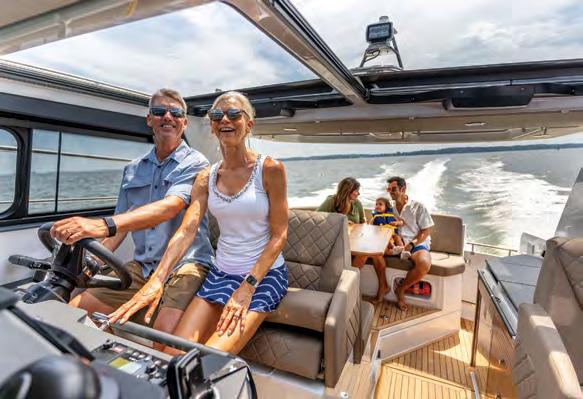


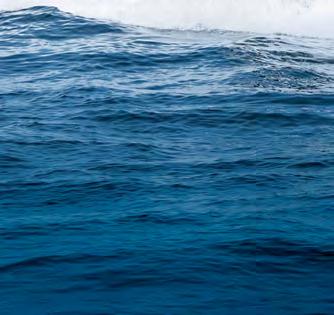

By Chuck Warren
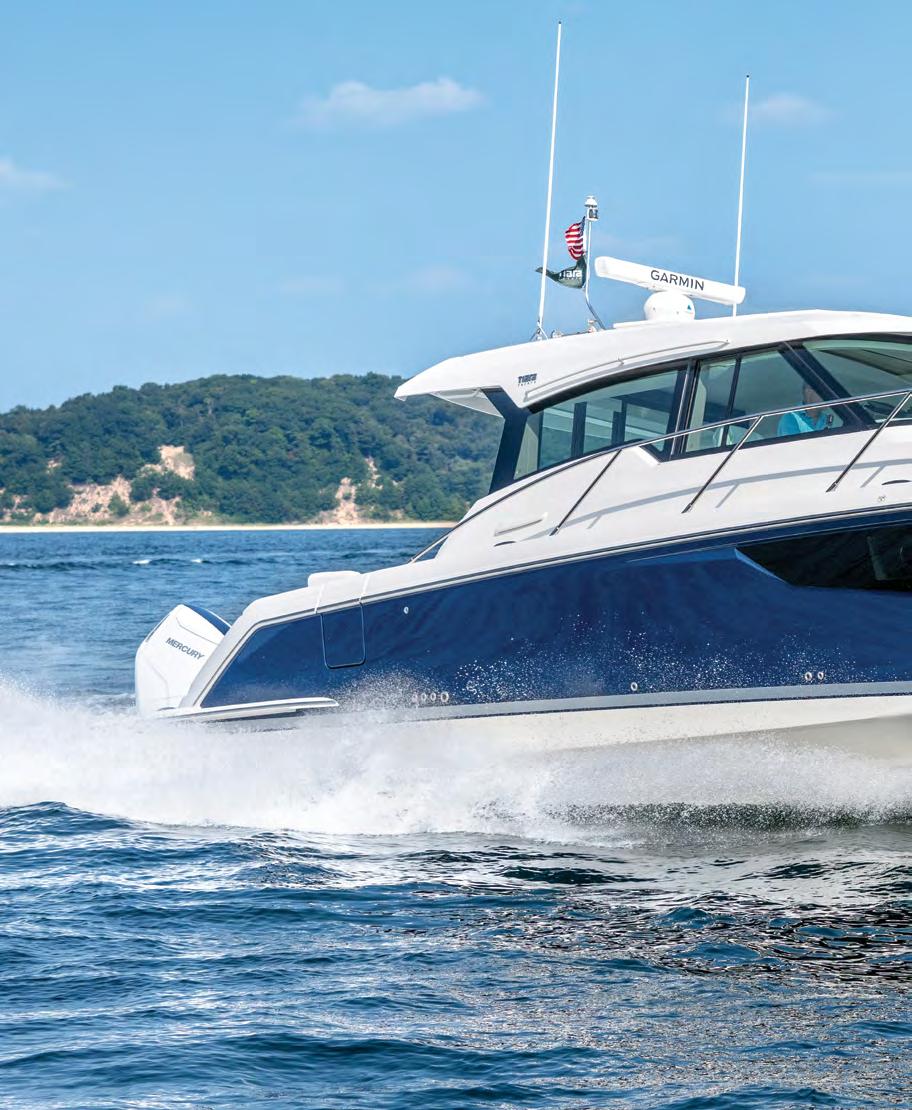
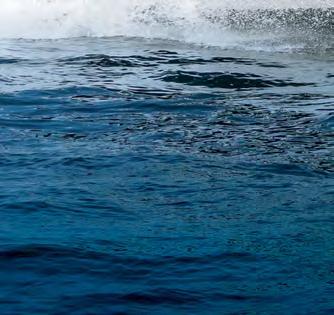
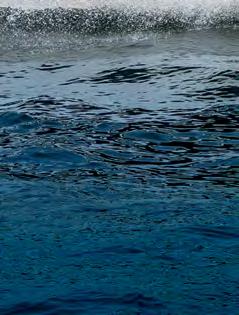
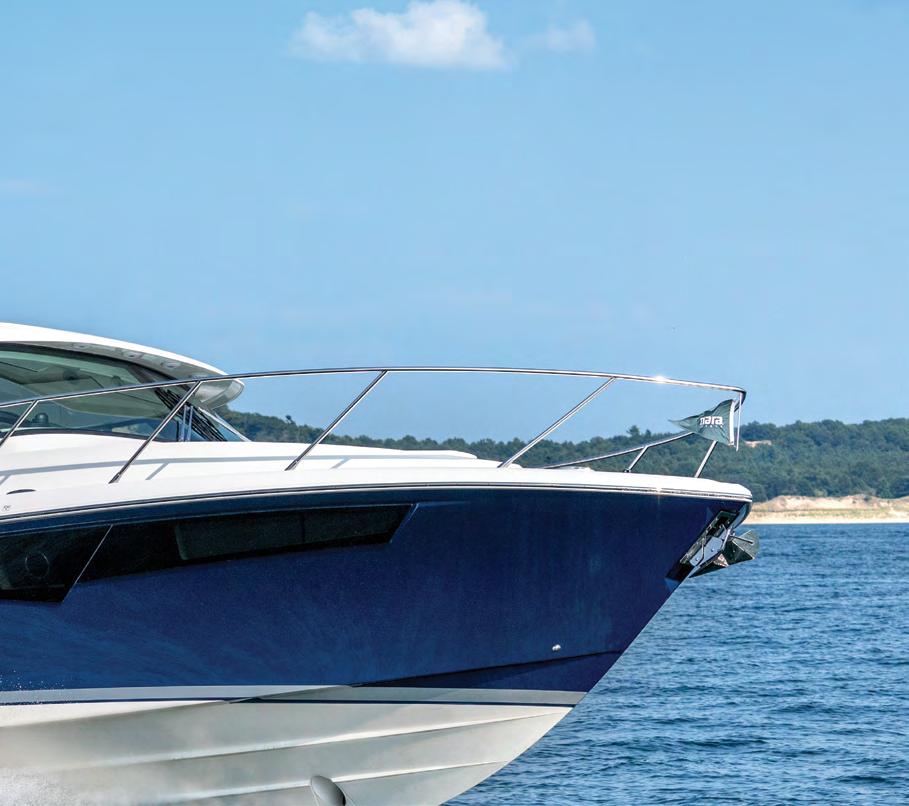
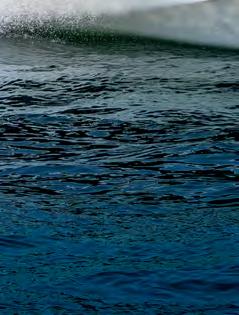
The Great Lakes have a long and storied maritime history, so it should be no surprise that Michigan has been the source of many significant contributions to the pleasure boating industry.
Based on Michigan’s western coast, Tiara Yachts has been building highquality, great-performing luxury powerboats for over 50 years.
In response to a growing demand for pleasure boats, Leon Slikkers, founder of Tiara Yachts, was an early adopter of fiberglass and composite construction while at the helm of his first company, SlickCraft.
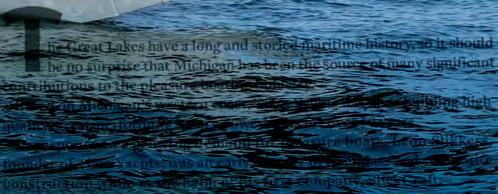

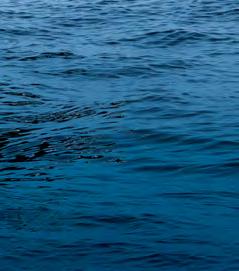


Today, Tiara Yachts is one of the boating industry’s true gems and perfectly embodies the Slikkers family’s commitment to producing some of the finest pleasure boats on the water.
With all of that in mind, I arrived at the company’s Holland, Michigan, waterfront venue for a test ride on the newly redesigned Tiara 43 LE, which was given a facelift for the 2025 model year.
The Tiara docks were populated with the company’s latest models, but the 43 LE, or Luxury Express, was easy to spot. I stopped walking one slip short and stepped out on a finger dock to get a good look.
The boat looked really sharp with its dark blue-gray hull and white exterior color scheme. Tiara always seems to find the perfect balance of straight lines and curves, and the 43 LE is a great example.
At the transom, two Mercury 600-hp outboards leave a good amount of space for swim platform foot traffic and sit low enough to blend well with the lines of the hull. There is plenty of room ahead of the engines for
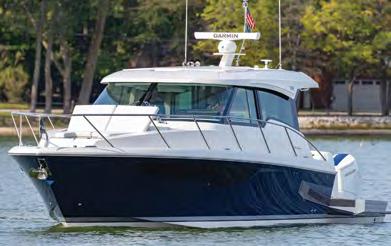

boarding, getting in and out of the water, or making good use of an aft-mounted grill.
The 43 LE also features a starboard hullside boarding door and step pads on both sides to make it easy to board from any dock.
In the cockpit, the test boat featured Tiara’s U-shape Buffet Lounge module. The seating can be spun on its centerline to several positions, including one that gives an unobstructed view without including the outboard engines. The seating can also face to port, where a large folding hullside terrace adds a considerable amount of space to the already roomy cockpit.
The aft end of the Buffet Lounge houses an electric grill, while lifting the compartment door below the grill opens a large trunk with plenty of space for life jackets, spare lines and fenders.
The Buffet Lounge module can also be replaced with an Adventure module, which includes a work surface, a cutting board, a 30-gallon livewell, rod holders and other details aimed toward fishing.
Two comfortable seats flank the cabin’s sliding access door, which opens to starboard. To port, an electrically actuated

window drops down so that almost all of the salon’s aft end is open. This gives the salon an open, airy feel and makes the cockpit and salon feel like one space.
Both aft seats hide finished, insulated storage compartments, while an optional refrigerated cooler box is available for the starboard side. Drink holders are plentiful, while USB A and C charging ports are easy to find.
A large panel in the cockpit floor provides easy access to a machinery space, which includes a 7.5-kw diesel generator and maintenance items like pumps, tanks and pickups. There is also plenty of room for an optional Seakeeper gyro system.
Inside, the salon, helm and galley are nearly entirely surrounded by glass. The result is a very well-lit space, and with the back window and door open, the area feels airy and bright. The forward windows can be opened to provide passive venting, while the huge sunroof brings even more of the outside in.
On the aft starboard side, the galley is comfortable and usable with an induction
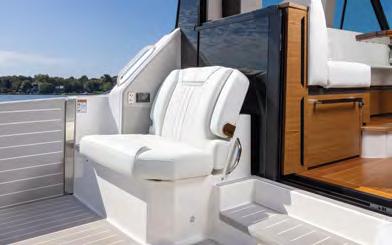
SPECIFICATIONS
LOA: 43'6"
Beam: 13' Draft: 2'3"/3'5"
Dry Weight: 24,000 lbs.
Fuel Capacity: 540 gals.
Max Power: 1,200 hp
Hucks Marine HUCKS.CA T
Price: Contact dealer TIARAYACHTS.COM
DEALERS
SkipperBud's SKIPPERBUDS.COM
Walstrom Marine WALSTROM.COM
cooktop, more cold storage than expected, and lots of extra storage close at hand. Also to starboard, a 43-inch hi-low TV can be hidden when not in use to maximize the view and light in the salon.
To port, the salon seating can be easily converted from a forward-facing passenger seat into an additional lounge seat, or the entire lounge can be converted into a comfortable berth. This setup makes the space even more versatile and comfortable.
The helm is well designed with important switches within reach. Two 16-inch Garmin GPSMAP touchscreens provide navigation and controls, while an optional third display can be placed on the passenger side.
The joystick controls for the big Mercs, the bow thruster and other features like Zipwake’s dynamic trim system are all easy to access and well-placed around the adjustable wheel.
Down a few short steps is easy access to a large head with an enclosed shower. A hullside window with an opening porthole makes the space even more comfortable. Forward, a very


Extensive list of standard features
Flip-up table in the cockpit makes access to seating a breeze
Convertible lounge seating in the salon provides great options
Choice of aft cockpit configuration
Wireless phone charge pads alongside the owner’s stateroom bed
roomy owner’s stateroom includes a queen bed and lots of storage everywhere.
Turning aft, a very large private midcabin for guests includes a full-size bed, lounge and TV, with plenty of light streaming through a hullside window.
Although the guest quarters are not full-height, the mid-cabin entryway is, providing guests with a roomy, full-height space to make dressing easy and private.
It would be hard to imagine a better day for a boat ride on Lake Michigan. Clear skies and cooler temperatures made for a beautiful day, especially since a light breeze left Lake Michigan nearly flat.
We headed out of Lake Macatawa, past Big Red, Holland’s famous lighthouse, and out to the big lake’s glassy surface.
The first thing I noticed was the incredibly silent ride. Mercury 600s are impressively quiet engines, but there was so little noise from the hull as it crossed the few ripples and our own wake that it caught me by surprise.
A few hard turns gave a clear picture of the boat’s handling and stability, which



�
I seriously can’t think of anything other than “I don’t have one”
� WATCH THE VIDEO AT LAKELANDBOATING.COM
were exactly what I’d expect from a Tiara. The big Merc outboards also pushed the boat quickly up on plane with minimal effort and almost no bow rise.
Throttling up, it took little time for the boat to top out at just under 50 mph, where the boat felt perfectly at home and gave a smooth, dry, extremely comfortable ride. Even coming off plane, there was never a loss of visibility over the bow.
The 2025 43 LE is nicely equipped right out of the factory but can also be ordered with a nice selection of options such as FLIR thermal imaging and electrically foldable antennas so people can rig the boat to match their wants and needs. Paint colors are also customizable with a wide variety of choices available to personalize the boat. The 43 LE is even pre-wired for Starlink satellite internet if connectivity is important.
The previous version of the 43 LE was a beautiful boat so it’s hard to imagine a big improvement. However, for 2025, Tiara managed to take a finely polished gem and bring out an even brighter shine.

By Craig Ritchie

Sixty years ago this December, the first batch of coho salmon eggs arrived in Michigan from the west coast, forever changing the Great Lakes and creating one of the most spectacular freshwater sport fisheries in the world.
December may not be the height of boating season on the Great Lakes, but this December marks a very special anniversary for boaters across the entire watershed. Exactly 60 years ago, a shipment of 1 million coho salmon eggs arrived in Michigan — an event that forever changed the Great Lakes for anglers and boaters alike.
But 1964 wasn’t the first time Pacific salmon had arrived here. Michigan, Wisconsin, Ontario and other Great Lakes jurisdictions had begun experimenting with introducing Pacific salmon to the big lakes as early as 1866, as stocks of native species declined. However, the water quality issues that impacted native fish also precluded the introduced salmon from becoming established, and those early stocking efforts were abandoned and forgotten by the turn of the century.
The opening of the St. Lawrence Seaway in the late 1950s changed everything. The newly completed locks on the St. Lawrence River, along with newly expanded locks on the Welland Canal, not only enabled ocean-going ships free passage throughout the Great Lakes, they opened the door to the arrival of two invasive species which each played key roles in changing the ecosystem forever.
Parasitic sea lamprey — eel-like creatures sporting sucker mouths lined with sharp teeth — found their way into the lakes and feasted
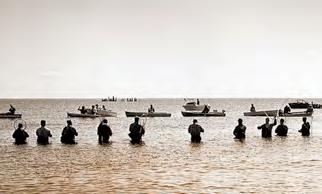
on native lake trout. They promptly spread throughout the system and virtually wiped out lake trout populations in all but the most remote pockets of Lake Superior. Coincident with their arrival came vast schools of alewife, a cigar-sized herring which, in an environment now lacking deep water predators to eat them, bred like crazy and became the dominant species of fish, at one point representing more than 90% of all aquatic life in the lakes. Mass die-offs of alewife each spring following their annual spawning cycle left shorelines clogged with tons of dead, decaying fish, with cities using steam shovels and bulldozers to combat a mounting health hazard. Clearly, something had to be done.
By the mid-1960s federal lamprey control programs began bearing fruit, making it possible to begin restoring Great Lakes fish populations. The turning point came in 1964 when a fisheries biologist named Dr. Howard Tanner began working with the Michigan Department of Natural Resources (DNR). Tanner knew that the only way to bring alewife populations into check was to reestablish a population of predators to feed upon them. Native lake trout were the logical choice, but their slow growth rate meant it could take decades before anyone knew if the plan was working. Tanner was aware of prior, unsuccessful attempts to introduce Pacific salmon to the Great Lakes, and he felt that this time, with the water stuffed with prey fish, the results could be different. Unlike slow-growing lake trout, coho salmon from the Pacific mature by their third birthday, so it would not take long to gauge the success of his plan. Measuring those results would be as simple as observing how many adult fish returned to their original stocking sites to spawn each fall. Tanner wouldn’t have to go hunting far offshore looking for evidence of success, it would swim right back to him. Beyond that, coho enjoy a global reputation as great sport fish, known as hard fighters and delicious table fare, meaning Tanner’s alewife control program could also create an all-new fishing opportunity. A successful salmon introduction could boost tourism and inject fresh money into small towns all along the
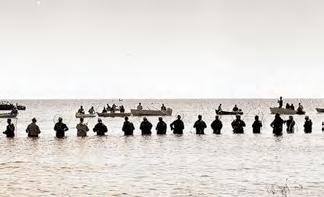

lakeshore. What’s more, because coho grow so quickly and live near the surface of the lake rather than down on the bottom, they were far less likely to accumulate concentrations of chemical contaminants than lake trout of equivalent size and be safe to eat — an important consideration given the state of the Great Lakes ecosystem at the time.
After receiving the requisite approvals, Tanner arranged to acquire one million coho salmon eggs from Oregon. Those eggs arrived in Michigan in December 1964.
Some 18 months after the eggs arrived, with the then finger-sized salmon ready to be released into the wild, Tanner himself freed the very first coho into Michigan’s Platte River in April 1966. By the fall of that year, a small number of earlymaturing salmon returned to their stocking sites and began showing up on angler’s fishing lines, impressing with their ferocity and fight.
By the time the first large returns of fully grown adults returned to the Platte and other tributary streams in the fall of 1967 — some now weighing more than 15 pounds — the hard-fighting coho had attracted the attention of anglers from across the region. Once sleepy lakeside towns suddenly bustled with activity, motels filled to capacity and restaurants began operating on extended hours as “salmon fever” descended across Michigan.
Witnessing the substantial economic impact of the new fishery, other states promptly launched their own coho programs. Tackle companies worked around the clock to keep up with booming orders for new gear, and boat dealers in the region saw huge demand for larger vessels capable of fishing farther offshore. Salmon derbies began to spring up all across the lakes, huge charter fishing fleets grew out of nowhere and intense media coverage drove more and more people to the region.
Today, the coho salmon that launched the Great Lakes fishing boom have been joined by larger Chinook salmon and smaller pink salmon, injecting some further muscle into what is already considered one of the most important recreational fisheries on earth. Alewife populations have been brought down to sustainable levels, and self-sustaining populations of coho, Chinook and pink salmon


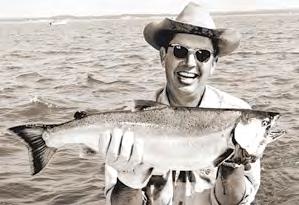
have developed in multiple areas across the watershed. Even native lake trout, stocked alongside the salmon for decades, have finally begun to show signs of recovery.
The impact of the salmon program on Great Lakes boating cannot be overstated. In the six decades since those first coho arrived in Michigan, municipal, state and federal spending on boating infrastructure projects in the region has soared, creating new launch ramps, docks, upgraded harbors and facilities for boaters on both sides of the international border. Boat builders continue to enjoy strong sales of large offshore vessels designed with salmon fishing in mind. Fishing tackle companies building all manner of specialized salmon equipment continue to thrive, and the salmon fishery remains a key driver of tourism across the Great Lakes. And, even more importantly, the salmon have reconnected hundreds of thousands of people with the lakes and made millions more aware of the need to protect healthy aquatic ecosystems.
So let us celebrate the 60th anniversary of the coho’s arrival in December 1964 — a fish that forever changed the Great Lakes and made us all the better for it.
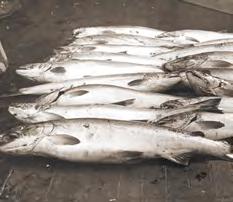

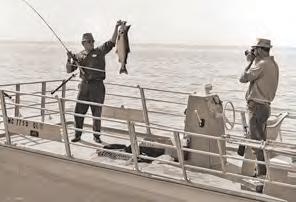


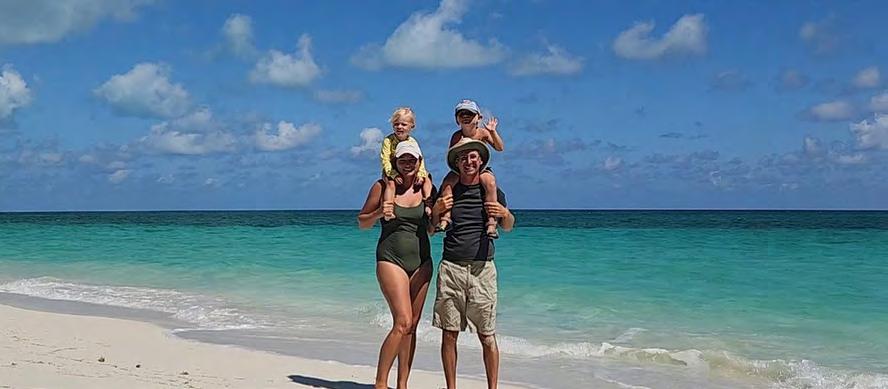
By Allison Hoogerwerf

A young Michigan family, burned out from the daily grind, sails to the Caribbean in search of adventure.

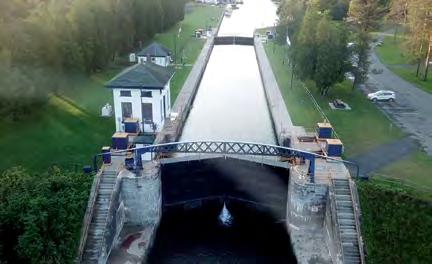
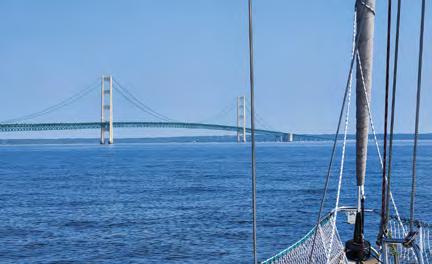

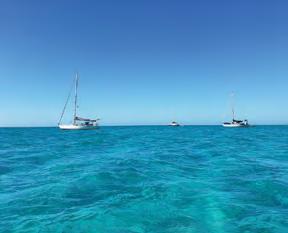
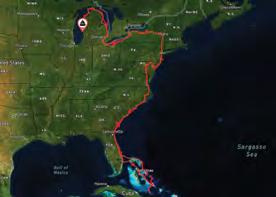


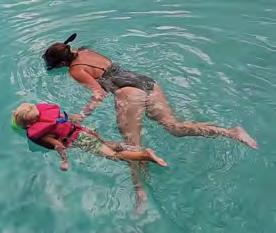
At the heart of every boater is a sense of adventure — a desire to feel the rhythm of the waves beneath and to breathe in the wide open sky above. So many of us dream of distant ports, secluded anchorages and a longing for wildness. My husband and I have long dreamed of sailing to the Caribbean to find a way to separate from the daily grind of the American hustle culture. There is something so appealing about casting off and finding a new way to be in the world.
But there never seems to be a perfect time for adventure. There are myriad excuses boaters make that leave us tethered to the dock: A lack of funds, endless projects, traditional jobs, children and families, or simply a hefty dose of fear for what may befall the passengers on a grand voyage.
While we haven’t yet made the leap to cast off, we are privileged to know the captain and crew of Kasablanca, a Beneteau First 40.5, who have shown us that it’s possible to set land life aside and follow the lakes to the open sea.
In the summer of 2022, Steve, Felicia, Vincent (3) and Clara (2) set out on an adventure of a lifetime. Leaving from Holland, Michigan, they sailed through the Great Lakes and out the Erie Canal to the Bahamas and back in a year — an incredible and important year.
When I asked them what it was like to prepare for the journey, they told me they never really committed to the trip, they simply committed to the next task or the next project that would bring them closer to being ready. They dreamt and they planned, and step-by-step they made the dream a reality. They never fully committed to a plan because they never wanted to feel like they failed if they did not go or if they turned around before they intended to; because no matter the length or the destination, the journey was necessary.
Felicia has spent her career as an emergency room nurse and the years of the pandemic were crushing her spirit. She questioned her vocation and whether or not she could continue in nursing. Steve is an engineer with a demanding job.
Feeling broken, burned out and tired, the couple listened to the pull of the sea to find freedom — to let the water and wind remind them of the beauty in the world and to show their children a life that opposes the cultural norms in America. Having made the same trip without children in 2015, the couple had some idea of what to expect as they set out.
Being at the mercy of the wind and waves forces you to be in tune with your surroundings in an entirely new way. Felicia notes how aware she became of everything they consumed, every ounce of trash they produced and every gallon of water utilized. Being in a contained space, she says it’s easier to see the impacts one person can have on the world. There is a beautiful world out there that we can spoil and destroy if we aren’t thoughtful about the way we interact with the elements around us. We must be intentional about protecting the pristine waters and the creatures that live within the sea.
Throughout the trip, they spent roughly a third of their time getting to the Bahamas, a third exploring the islands and a third coming north again. The nights were often spent poring over charts and weather reports looking for the next window to move further south.
Once they were well on their way to the Bahamas, they connected with two other “kid boats,” and the families formed a connection that amplified their journeys. The three boats became a tribe that would move together, grow together and support one another along the way.
Steve and Felicia explain that it can be challenging to make genuine connections and friendships in their life on land. Perhaps life just gets in the way, and working full-time makes it difficult to find the time to pour into forming and maintaining new relationships. But on the water, they felt at ease settling into friendships. There was a common goal, shared understanding and a willingness to help each other that can be hard to find on land.
As they sailed into the pristine waters of the Bahamas, the crew unplugged further and settled in to enjoy the beauty they had spent months moving toward. The clear water led them to spend hours snorkeling and exploring beneath the waves. Vincent watched the older children in their little tribe and quickly learned to swim. He loved watching the
creatures underwater. Steve was able to snag some fish while spearfishing. In this beautiful and wild place, the whole world is a bit like a playground — for the kids and adults alike.
Even though the family had arrived at their destination, it was still incredibly important to watch the weather daily; they needed to ensure they were in appropriate anchorages for the wind and wave conditions to plot their course forward hopping between islands. Each island held a new chance to explore. There were hiking trails, beaches to comb for treasures and even wild pigs! The children played in the sand while the slow pace, fresh air and sparkling water restored the adults.
Ever-changing technology played a role in many areas of their trip and helped them form connections. The couple used the No Foreign Land app to find and leave reviews of the anchorages and towns they visited. They also utilized an app that allows “kid boats” to connect with other boats with children aboard. Steve notes that having Starlink onboard was an added safety precaution as they always had access to the internet so they could obtain information if problems arose. As technology continues to expand, so does the number of liveaboards out on the water. Many people are able to work remotely from distant and remote places.
As I imagine the family sailing in tropical blue waters, snorkeling with colorful fish and slowing down to the pace of the wind, it’s easy to forget that life afloat also comes with the challenges of everyday life on land. They dealt with potty training, sibling conflicts, sailing through large and uncomfortable waves for 10-12 hours, seasickness and a handful of colds and fevers throughout the year. Living on a boat full-time does not solve everything. Some pressures of daily life fade away and new trials arise.
To be out there for an extended time, Steve shared that one of the most important attributes of a captain and crew is a willingness to learn new things and unending determination to solve the problems that arise along the way. Steve is a master problem solver and suggested that the best way to feel prepared is to know that you will never leave the dock if you expect to know it all before you go. There will always be things that break, problems to solve and weather to mess with the best-laid plans.
While their kids were young on their journey and may not have concrete memories of the year afloat, Vincent and Clara were marked by this adventure. Their parents instilled in them an idea of what is possible and showed them a world that is broader than their neighborhood. They are capable and strong, flexible and engaging children who have an innate sense of wonder. The children remember the friends they made along the way and verbalize a desire to live on the boat again some day. Was it ideal to leave the dock with kids in diapers? Probably not. But it was also not a reason to set the dream aside.
“The highs are much, much higher,” Felicia says, “but the lows are the same.”
They had a strong desire to listen to the pull of the sea and find much needed grounding where there was no ground beneath them. They could have found unending reasons not to go, but they knew the importance of the journey.
When the family returned, they had to recalibrate to life on land. The boat felt like home even though they were technically back “home” in their house. They felt far from each other as they slept in different bedrooms instead of snug in their berths. The ease of using a car to get groceries felt like a luxury. Consumerism and waste were apparent in new ways. Through it all, they became more in tune with the world and with each other. They returned more patient.
Steve and Felicia both felt that the year was worthwhile in every way. They don’t know when their next voyage will take place, but the idea and the desire is there.
Perhaps there will be a time in life that presents itself and feels just right for adventure, but I think it’s more likely that there will forever be something that can stand in the way if we let it. Perhaps the best way to find ourselves in wild spaces is to do just as the crew of Kasablanca did — create a plan and slowly take one step toward the dream until it becomes a reality. May their story awaken all of our spirits to adventure, for our souls sense the adventure that awaits.
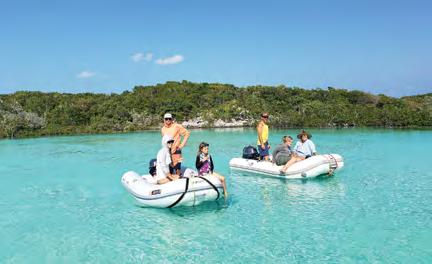
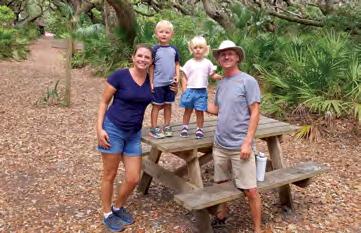





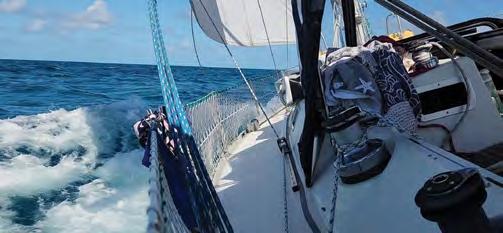

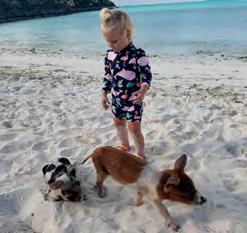
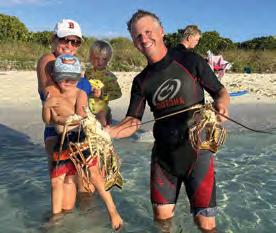







By Craig Ritchie




Nestled along the south shore of the Gulf of St. Lawrence, Prince Edward

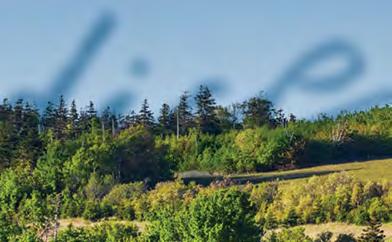
may be Canada’s smallest province, but it stands unmatched as a unique and magnificent port of call for cruising boaters.
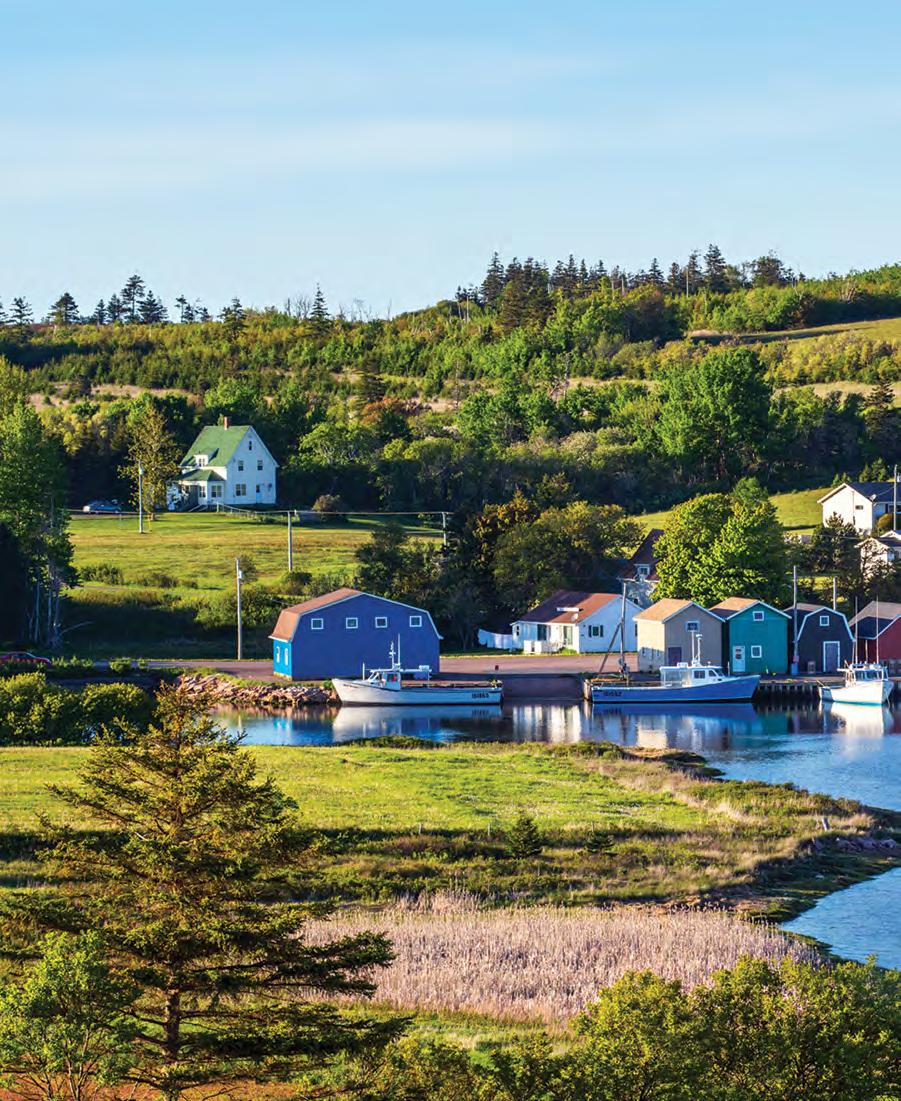













One of the great joys of boating on the Great Lakes is the ability to take off on a moment’s notice for a day of offshore fun. But now and then, we’re drawn to explore farther afield, especially when that involves extended trips to more distant ports of call. For a growing number of cruising boaters, that means extending their travels down the St. Lawrence River to coastal destinations like Prince Edward Island.
Nestled along the south coast of the Gulf of the St. Lawrence, Prince Edward Island — or PEI for short — may be Canada’s smallest province by area, but it ranks among the country’s top tourism destinations, especially among foodies with its global reputation for oysters, lobster, scallops and blueberries. It’s also increasingly known as a boater’s vacation playground, recognized for its laid-back attitude, carefree pace and tremendous recreation opportunities. That’s especially true if you choose to explore the island the old-fashioned way — by boat.
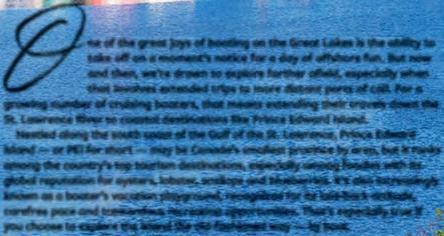

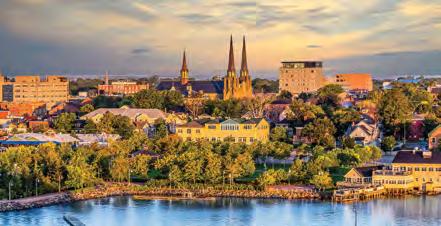
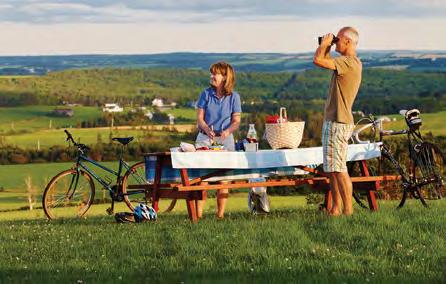
Boats have been part of island life for centuries. In fact, it wasn’t until the opening of the eight-mile-long Confederation Bridge in 1997 that PEI enjoyed a road link to mainland Canada. Until then, it was accessible only by boat or air.
Although commercial lobster boats working the seafood trade continue to dominate most harbors, a growing number of leisure boats can be seen in virtually every port today as a new generation of islanders choose to reconnect with the sea. Marinas with outstanding facilities for recreational boaters now ring the island, making PEI an enticing destination for long-distance cruisers who want to not only experience different sights, sounds and tastes but also return home refreshed and healed from the grind of everyday life.
Since no point of land on Prince Edward Island sits more than 10 miles from the sea, boaters enjoy tremendous access to virtually all of the island’s best destinations with a perspective that’s second to none. A couple of bicycles onboard puts every point of PEI within reach.
Prince Edward Island is Canada’s smallest province by area (at just 174 miles long and no more than 40 miles wide) and by population, with only around 157,000 permanent residents. So if you’re looking for gridlock,

you’ve come to the wrong place. Forget about lining up for slip assignments here or waiting for the fuel dock, as life on PEI moves at a far more civilized pace than it does on the mainland. It’s a great place to get away from it all, especially if you want to just spend a night on the hook. In many places, you’re more likely to share your anchorage with seals and bald eagles than with another boater. True solitude is never far away for those who seek it.
And for those who want a more cosmopolitan experience, that’s just a short ride away. Tie up in downtown Charlottetown and you’ll find the best of PEI’s most populous city lies within easy walking distance from the harbor. Self-guided walking tours help you explore the city’s magnificent architecture and history at your own pace and discover a truly unique place that celebrates its past while striding firmly into the future.
Charlottetown’s historic waterfront district, with its brightly painted, wood-sided buildings and statuesque sandstone warehouses, has been transformed from a one-time commercial center into one of Canada’s most charming downtowns, offering beautiful homes, a vibrant shopping scene and a number of outstanding restaurants. Charlottetown is unlike most urban centers today, which are dominated by chain stores and corporate restaurants. This is Canada the way it used to be, with the majority of businesses and restaurants operated by the families who own them. That includes trendy Peakes Quay,
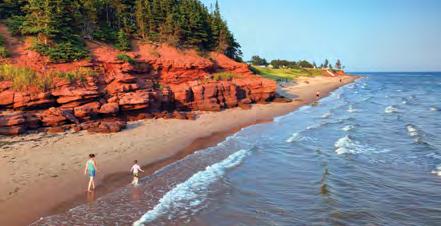
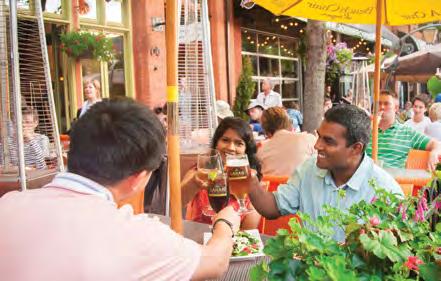
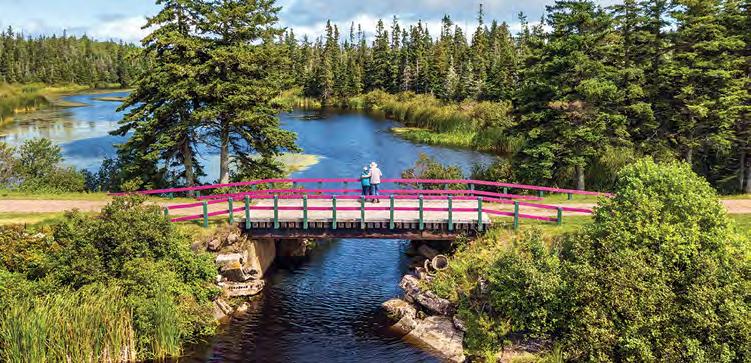


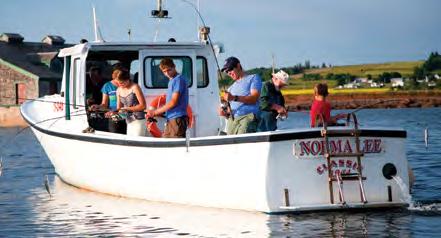
right on the waterfront at the marina, which offers fine dining mixed in among the souvenir shops.
Victoria Row — a pedestrian street between Queen and Great George Streets — is dominated by boutique shops and restaurant patios sprawling under a canopy of trees. Only a short walk from the city marina, it’s one of the city’s most popular destinations for visitors with its myriad attractions, including live music on the street most summer evenings.
Just a short distance to the west, PEI’s other major city, Summerside, also offers slips in the heart of downtown, with most of its charms within easy walking distance of the docks.
Smaller and perhaps a bit quieter than Charlottetown, Summerside has emerged as PEI’s tech hub, with a number of aerospace firms having taken up residence at its former air force base. Its downtown boasts a range of small shops, family-owned restaurants and bakeries, making a day or two in town more than worthwhile.
In spite of Charlottetown and Summerside’s more urban charms, to really appreciate PEI you need to leave the city lights behind and go explore the many charming fishing villages that ring its shores. Along the way, slow down and enjoy the brilliant cobalt blue waters lapping at red sandstone cliffs capped with brilliant green fields. The views in every direction — highlighted by all manner of differently shaped lighthouses — are straight out of a tourism brochure.
The island’s trademark red soil takes its color from the high iron oxide content, which rusts on exposure to air. You’ll see it everywhere, on rural roads and all along PEI’s expansive sand beaches. For a truly unique souvenir, pick up a dirt shirt — a plain white cotton tee that’s spent a few weeks buried under beach sand, which permanently stains it a unique reddish brown hue. Every shirt is unique, and you can buy them in most villages.
The island’s natural sand beaches rank among its greatest attractions, and by June, the water is the perfect temperature for a refreshing dip. It sounds surprising, but warmed by the sun, the shallow waters off PEI’s beaches are the warmest north of the Carolinas.
1. EAT SEAFOOD

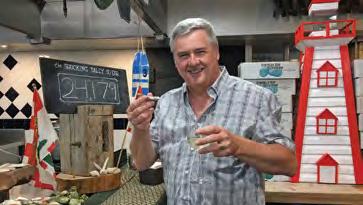
Malpeque Bay is famous worldwide for its superb oysters, and they’re featured in many of the island’s restaurants — including the legendary Malpeque Oyster Barn, within easy walking distance of the town docks. You can also try Carr’s Oyster Bar in the nearby community of Stanley Bridge, where you enjoy shellfish on the patio as you watch great blue herons patrol the shallow lagoon fishing for their own dinner. Or make your way to North Rustico and enjoy a fresh lobster dinner overlooking the harbor at the famous Blue Mussel Café — rated the finest seafood restaurant in PEI year after year.
2. GO TO A CEILIDH
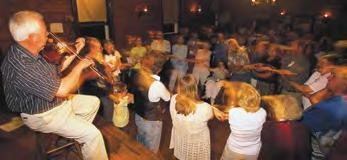
A Ceilidh — pronounced kay-lee — is a giant kitchen party, islandstyle! These festive affairs feature spirited live music, great food and tasty beverages. Just about every small town on the island has regular Ceilidhs throughout the summer months. Watch for signs or, better yet, ask around for the lowdown on what’s happening where.
The beaches are also a great place to see wildlife, whether it’s crabs and sea life trapped in tide pools by the outgoing tide or an almost endless variety of birds. More than 330 different species of birds can be seen on PEI, from giants like great blue herons, ospreys and bald eagles to offshore sea birds like gannets and petrels and shorebirds including endangered piping plovers. With such incredible diversity, it’s little wonder that PEI attracts bird watchers from all over North America. If you prefer more active pursuits, be sure to pack your golf clubs, since PEI offers more than 30 outstanding courses to choose from. For the most part, booking a tee time is easy, and green fees are comparatively cheap. The tough part is dealing with the sea breezes and simply keeping your eye on the ball, as the ocean views tend to be more than just a bit distracting.
3. SEE A LIGHTHOUSE
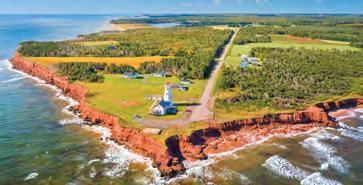

One would expect an island to have more than its share of lighthouses, and there are about 50 on PEI. Most are marked on the provincial road map, and many are open to the public. As to be expected, the view from the top has to be seen to be believed.

PEI’s north coast provided the dramatic inspiration for Lucy Maude Montgomery’s timeless classic “Anne of Green Gables.” Much of the story is set at the real life Green Gables farm, located in the community of Cavendish and now known as the Green Gables National Heritage Site. It’s a bit of a hike from the closest marina (take a taxi or enjoy an eight-mile bike ride through the National Park from North Rustico) but an interesting piece of Canadiana that attracts literally hundreds of thousands of visitors each year from all around the world.

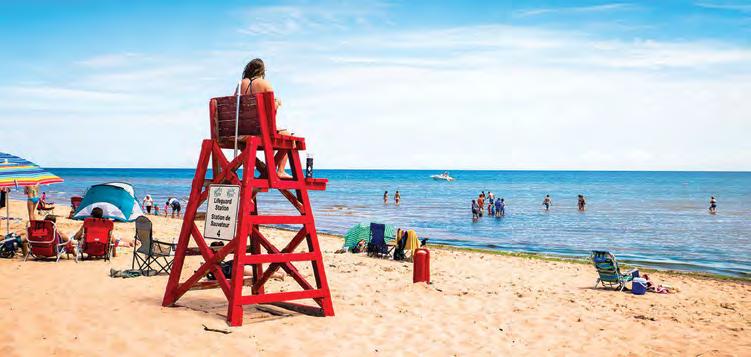
Start planning your trip with a visit to the PEI Tourism website at TOURISMPEI.COM, where you can find a promising list of gorgeous campsites and full information on a whole range of activities. It’s also where you can order maps, tourism guides and helpful information on local activities and more. Fishing guides, golf guides and cycling maps are all just a click away. Or, simply call 1-800463-4PEI and speak to an islander directly. They’ll answer your questions on anything from where to find the best seafood chowder to where to find pump-outs and 50amp power.
Golf not your bag? Then pull out the bike and go stretch your legs. Picking a route is as easy as consulting the provincial road map, with no shortage of glorious seaside journeys to choose from. Or try riding a section of the Confederation Trail, which stretches over a 170-mile path across the length of the island from Tignish to Elmira. Built on a former railway bed, it’s flat, safe and extremely well maintained, with small towns to explore every few miles and convenient parking access all along the way. Can’t fit a bike on your boat? There are dozens of places to rent bikes all across the island, including e-bikes for those who’d rather coast than pedal.
For the super ambitious, the newest craze on PEI is the Island Walk, a 440-mile coastal trek that essentially circumnavigates the entire province. It is said to take a little over a month to complete the trail, walking somewhere around 15 to 18 miles per day; however, most walkers break the trek into sections and do a different chunk each year.
If you’re not that keen to stretch your legs, consider taking a guided kayak tour. Kayaking is popular in most harbors including Victoria, Morell, Malpeque, North Rustico and Ellerslie, where local guides can teach you about the island’s unique estuary ecosystems. Kayaks provide a wonderful way to explore shallow rivers and inlets without fear of being stuck at low tide, while calm waters and spectacular views make the experience one you won’t soon forget.
Most kayak tours will also touch upon the seafood industry and explain those multiple rows of floats seen spanning most bays and coves. The floats reveal the location of mussel socks, used in the harvest of blue mussels for both local consumption and export all around the world.
Blue mussels are one of the most important shellfish crops on the island, and they’re harvested on rope-like underwater structures called mussel socks, which hang suspended in the water from the rows of floats. Mussel larvae drift freely in the current, looking for things to adhere to — normally rocks, but a hunk of rope also works as far as they’re concerned. Fishers simply lift the ropes from time to time and harvest mussels of market
size, leaving the smaller ones to grow. It’s a lot easier than diving and scraping bottom rocks, and a lot more productive as well. Each year, PEI mussel farmers harvest a whopping 37 million pounds of blue mussels to feed hungry diners across the globe. Most bays and coves on the island are dotted by mussel socks, their floats appearing as row after row of dotted lines in the water.
Virtually every small village in PEI has a place somewhere in the harbor to buy seafood straight from the water. The catch varies by what’s in season at the time, but you can usually rely on finding lobster, scallops, oysters, mussels and incredibly tasty haddock at any time of year.
PEI has long been known for its agriculture and seafood, so it comes as little surprise that the island has developed into a bit of a culinary mecca. Outstanding restaurants offering a dizzying array of fare can now be found right across PEI, and have given rise to a growing number of food festivals, including the PEI Shellfish Festival, Burger Love, Lobster Love and PEI Fall Flavours. There’s even a PEI Culinary Trail and some Culinary Boot Camps that allow visitors to fully immerse in a celebration of food quite unlike any other.
For the freshest seafood possible, dig out your fishing rod and try your hand at catching a striped bass. Native to the Gulf of St. Lawrence, striped bass populations crashed decades ago due to intensive commercial overfishing. However, a harvest moratorium has allowed striped bass — or as the locals call “stripers” — to rebound, and today they’re found everywhere along the island’s shorelines. The best way to catch them is by using floating popper-type lures that make plenty of commotion when retrieved. The fish attack floating lures with gusto, fight hard when hooked, and taste wonderful when pan fried in butter. Best of all, since you’re fishing in saltwater, there’s no license required.
PEI might be Canada’s most compact province, but you’ll quickly find there’s so much to do here that it’s tough to fit it all in just one trip. With excellent marine facilities and magnificent shorelines leading to adventure in every direction, it’s the kind of place that’s sure to leave one enchanted — and hungering to plan a return visit.
Marinas of Charlottetown

Peake’s Quay, SeaPort and Founders Landing (future)
902-629-9806
THEMOC.CA
Brudenell Marina
902-838-4778 mid-May to September 902-838-2528 rest of year THREERIVERSMARINAS.CA/SERVICES
Cardigan Marina
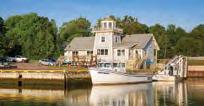
403-302-8435 May to October 903-583-2445 rest of year THREERIVERSPEI.COM/MARINAS
Charlottetown Yacht Club

902-892-9065
CYC.PE.CA
Montague Marina
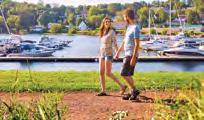
902-838-4778 (May to September) 902-838-2528 rest of the year
THREERIVERSMARINAS.CA
Murray Harbour Marina 902-962-2427
MURRAYHARBOUR.CA/COMMUNITY/ FACILITIES-AND-RECREATION
Silver Fox Marina & Summerside Yacht Club
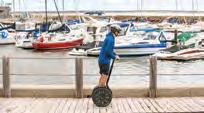
902-436-2153 SILVERFOXPEI.CA
Souris Marina

902-687-2233
SHAI.CA/HARBOUR-AUTHORITY/MARINA
Stanley Bridge Marina 902-886-2352
SBHA.CA
West Point Marina 902-859-1704
WESTPOINTHARMONY.CA/MARINA
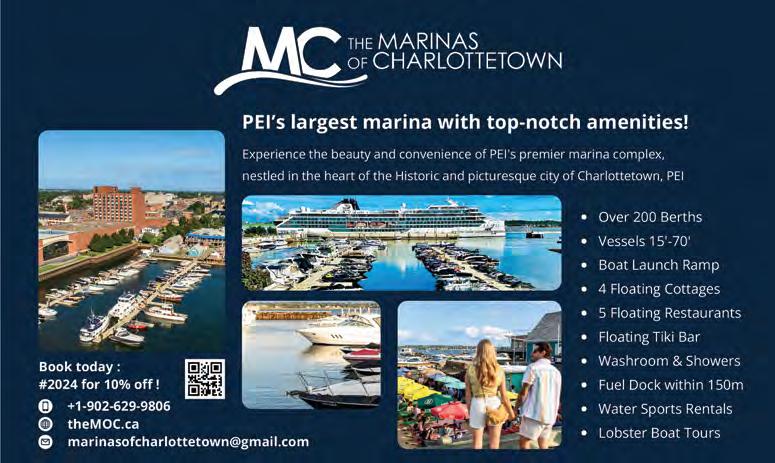
By Abby Thorpe



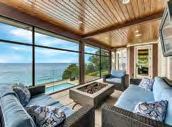
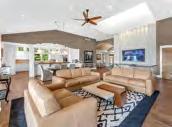
ADDRESS
18235 Spindle Dr. Grand Haven, MI 49417
SPECS
Bedrooms: 4
Baths: 4
Square Footage: 6,313
Acreage: 2.86
Shoreline: 150 feet
Price: $4,495,900
CONTACT
Sandi Gentry
RE/MAX Lakeshore
616-935-1150
SANDIGENTRY.COM
estled among the dunes on the Lake Michigan shoreline, this stunning custom home sits on 2.8 acres, offering incredible privacy. A private tram provides easy access to 150 feet of Lake Michigan frontage, while a gated entry guarantees peace and security.
The 6,313-square-foot home boasts a large kitchen with a walk-in pantry and high-end integrated appliances. The primary suite is located in a separate wing of the home for added privacy and includes a walk-in closet, luxurious bath and private office. On the opposite side of the home you will find a second bedroom and a full and half bath, while an elevator offers easy access to the walkout lower level.
Downstairs, a theater, full kitchen, family room, second laundry room, two bedrooms and two baths create the perfect space to relax, enjoy time with friends or family, take in the incredible
views, or plan exciting game and movie nights. A well-planned layout and plenty of space make this the ideal place for summer vacations, weekend getaways or full-time lakeside living.
Outside the lower level, a large pool and hot tub overlook the lake, perfect for those cooler days, or when you want a change from playing in Lake Michigan. An outdoor kitchen features a grill and skillet and offers unbeatable views of the lake beyond.
Four garage spaces and a home entertainment system add to the long list of upgrades in this lakefront home.
“This breathtaking custom-designed and built home is a lakefront dream come true, perfect for those seeking a relaxed lifestyle while also desiring an incredible entertaining space,” says the listing from Sandi Gentry, RE/MAX Lakeshore.
Welcome to your own private Lake Michigan escape. Just sit back, relax and enjoy the view!
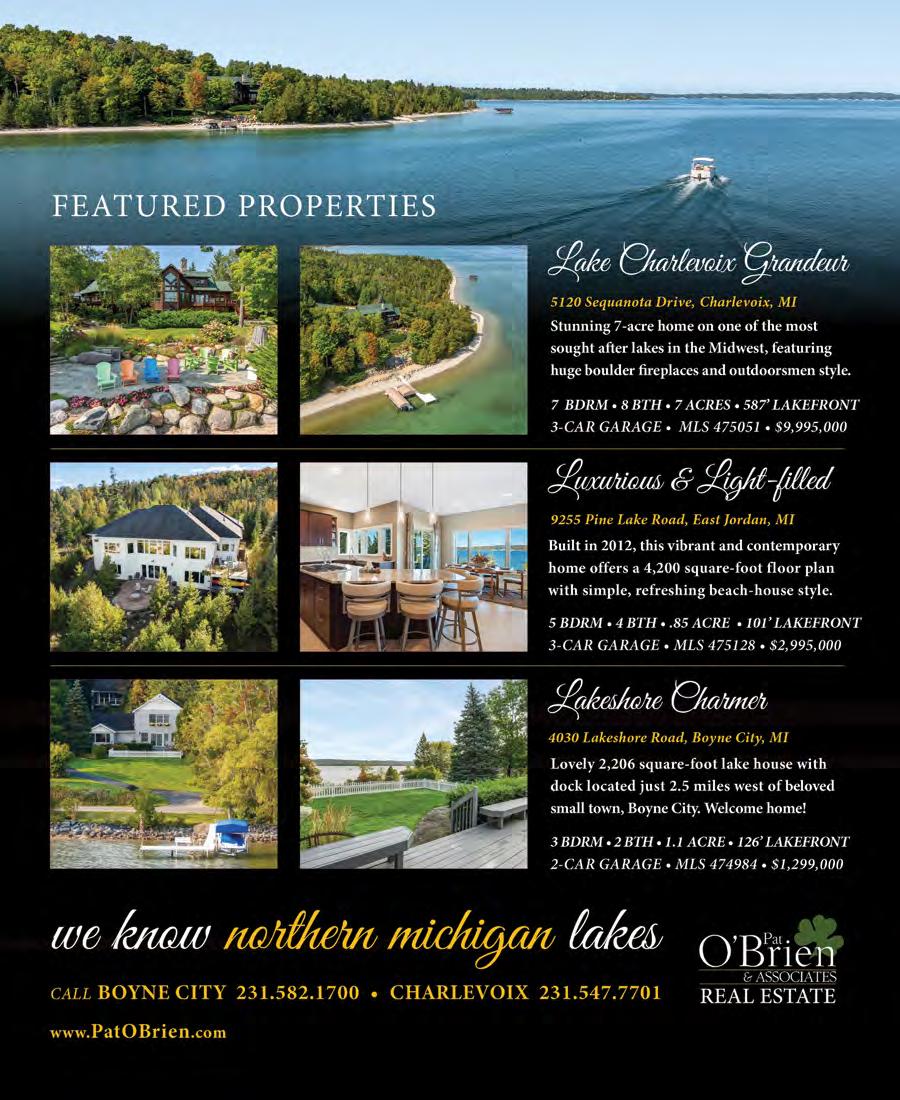
By Abby Thorpe



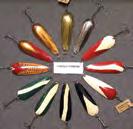
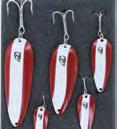

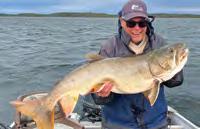
Dardevle by Eppinger 6340 Schaefer Rd. Dearborn, MI 48126 313-582-3205
A tradition that’s withstood the test of time.
Talk to any experienced angler on the Great Lakes today, and chances are they’ve caught their haul using an Eppinger lure, more specifically the Dardevle. There’s a reason the simple yet meticulously designed lures have become the iconic fishing spoon worldwide.
“It’s not the sexiest lure in town,” says Marketing Director and Plant Manager John Cleveland. “If you just want to catch fish, the Dardevle spoon does it day in and day out.”
The Eppinger legacy goes back to 1906, when Lou Eppinger began fishing with a lure he designed, and caught fish — lots of them. In 1912, he turned his prototype spoon into his first lure design, the Osprey. His nephew, Ed, joined the business in 1918, and the name changed to Dardevle after the “Devil Dogs” or “Dare Devils” — the name given to the 4th Marine Brigade that successfully penetrated and captured the Germans in the battle of Belleau Woods in WWI in 1918. The lure metal was hammered out so that it was
thinner in the middle and thicker toward the edges. When cast into the shallows, it swung from side to side, almost turning over but always righting itself.
Today, the business remains family-owned and run, with the reins passing to Ed’s daughter Karen in 1987, and now Karen’s daughter, Jennifer.
“It’s truly a family-owned business that runs like you’re part of the family,” Cleveland says.
Each lure is still 100% American-made, with painting/ processing done at the Michigan factory and stamping/ finishing done in Minnesota with Eppinger’s own proprietary, custom-made dies. The company now offers over 16,000 different sizes, shapes and colors of lures, but the Dardevle remains its most popular.
Anglers can visit Eppinger’s brick-and-mortar location in Dearborn, Michigan, and its wide variety of lures are available online and at many retailers worldwide. With holiday specials approaching, now’s the perfect time to invest in an Eppinger lure!












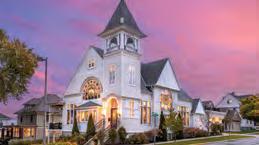














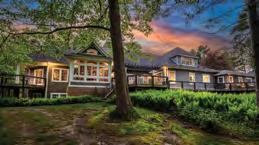


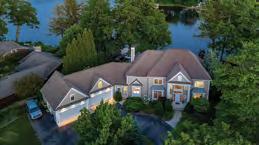









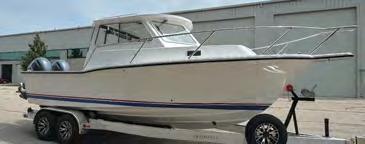


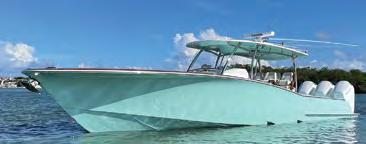




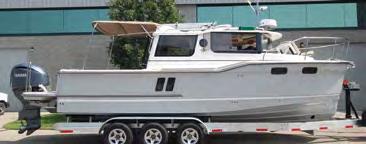
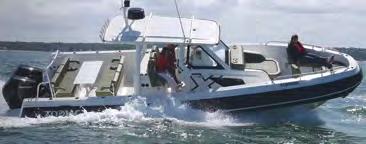

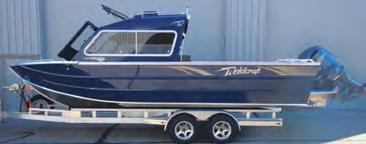


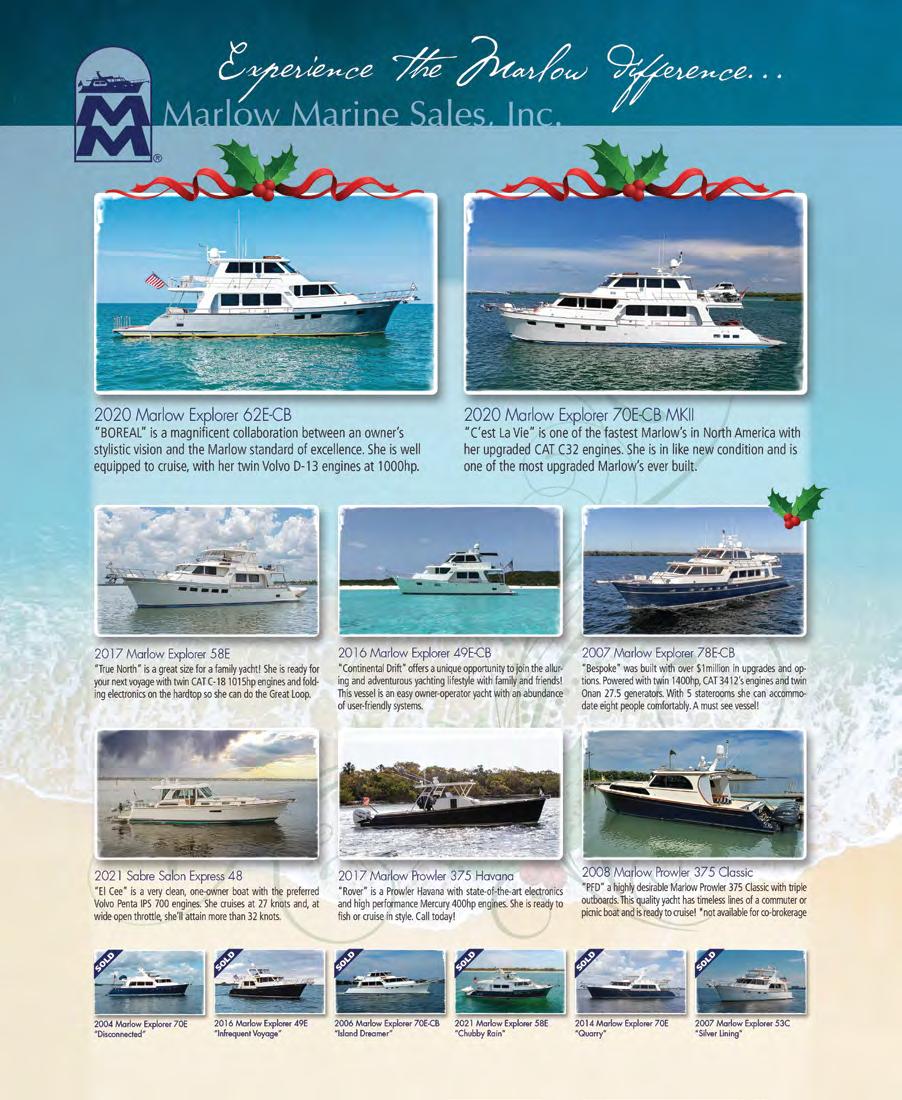

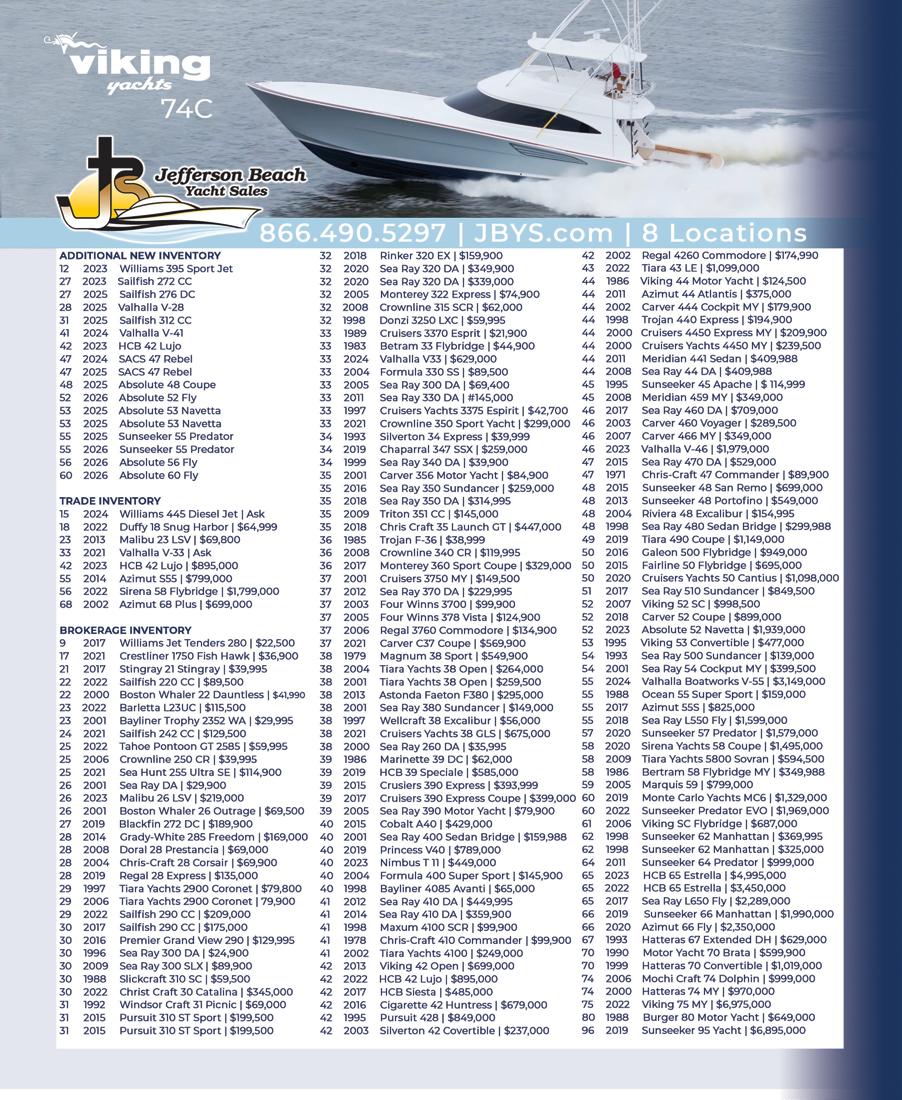

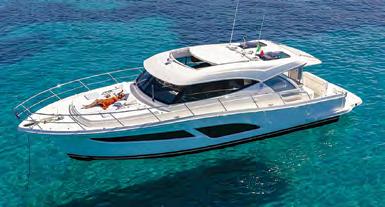






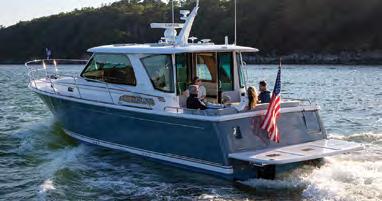




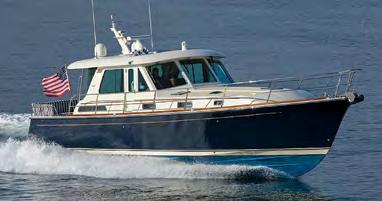










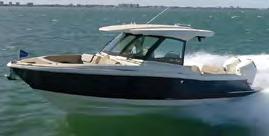


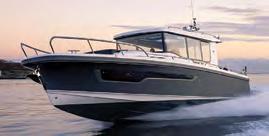


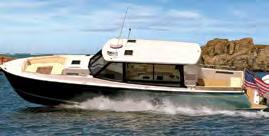
















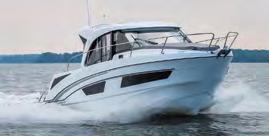

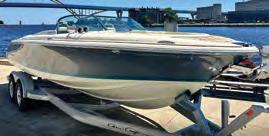




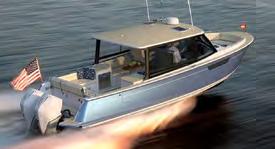


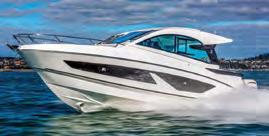




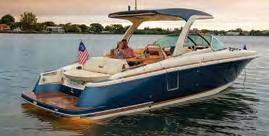

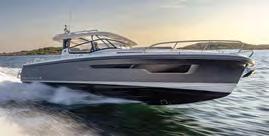


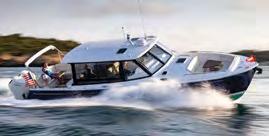

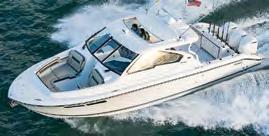


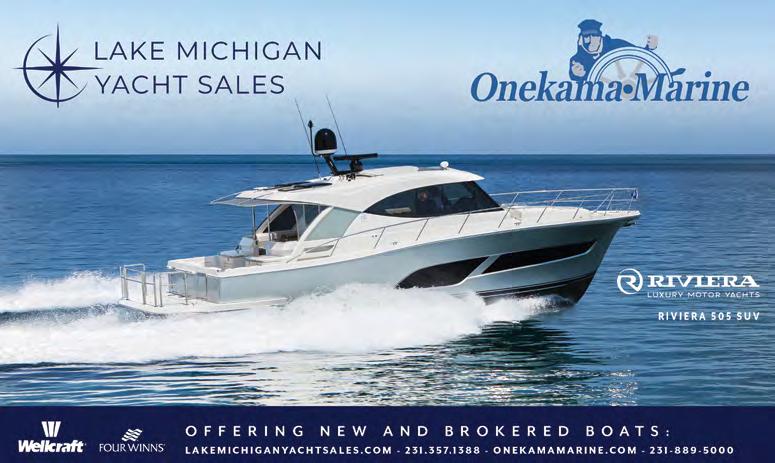













































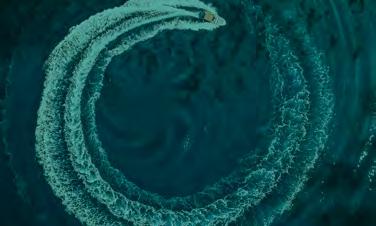








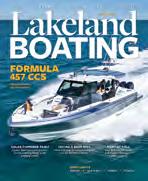











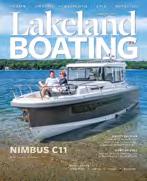



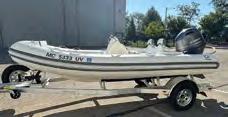
2022 ZODIAC YACHTLINE 490 DL w/Integrity
Trailer. Low hours, freshwater, turbo swing, sounder, stereo, cover, loaded! Asking $36,999. Call Brent @ 616-402-0180. RYS
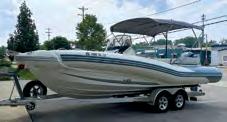
ZODIAC N-ZO 760 100% freshwater, one owner and only 47 hours on her Yamaha F300. Stored in indoor heated private building and only in the water when in use. She is loaded with options and comes with a custom all-welded bunk Integrity Tandem axle aluminum trailer. Asking $89,900. Call Bob @ 616-843-1225 RYS

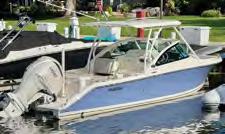
2023 PURSUIT DC 246 Fresh low-hour trade! On a trailer and ready for an adventure. Low hours on a Yamaha F300 (16 hours) and is properly equipped with the latest tech. Contact for more information or to set up an appointment to see at our Milwaukee location. Asking $159,000. Contact PJ Tamer for more information at pj@centerpointesales.com or 262-424-9627. CNT
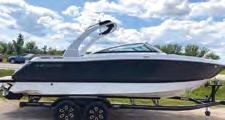

2023 FOUR WINNS H260 Check out this almost-new Four Winns H260. Gray with Mercruiser 6.2L 350-hp, only 10 hours on the engine. Tandem axle custom trailer, floor storage, anchor locker, head with sink, depth finder, docking lights, ski/wakeboard tower with Bimini top, JL Audio system, lots of under-seat storage, stainless steel cleats, swim platform, and much more! Asking $98,986. Contact info: tom@centerpointesales.com or 414-232-2955. CNT
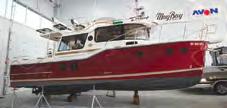
2017 RANGER TUGS R-29 COMMAND BRIDGE LE Freshwater, low hours, generator, AC, loaded! Asking $229,900. Call Brent @ 616-402-0180. RYS

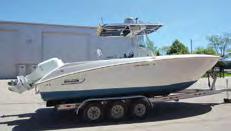
2006 BOSTON WHALER 270 OUTRAGE Cruise or fish — this boat can do it all. Ready to go w/ twin Mercury Optimax 225-hp outboards. USB and USB-C ports, Rockford Fosgate stereo w/ Bluetooth, Bluave amps with 8 Bluave speakers, Icom VHF marine radio w/ antenna, Lenco Trim Tabs, NOCO Genius Gen Pro Dual Bank Battery Charger. Comes with Vantage tri-axle trailer. Asking $52,900. Call Bob @ 616-843-1225. RYS

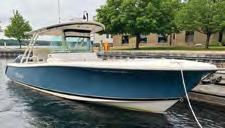
2013 PURSUIT ST 310 SPORT Freshwater, 409 hours. Well maintained, buffed and waxed in July. Twin 4 Stroke 300HP Yamaha Outboards, Lenco trim tabs, Raymarine touchscreen electronics. Wrap-around bow seating, ready to fish! Asking $169,900. Call Elijah at 920-973-5955. BAY


2009 WINDSOR CRAFT 36 HARD TOP Live the romance of the golden age of boating! Teak floors, rosewood dash panel and mahogany all around. Large galley cooktop and day grill. Power sunroof to enjoy a warm breeze on a perfect summer evening. Twin Volvo 5.7 Gi stern drives with only 186 hours. Asking $239,000. Contact Chris DePrey @ 920-366-4320. BAY
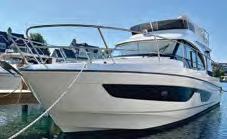
36' 2022 BENETEAU ANTARES 11 FLY Excellent opportunity, 100% freshwater, well-maintained. Popular Beneteau model. Options include: joystick w/autopilot, Panda generator, AC, Garmin Elect. incl. radar, VHF, plotter. Full galley, 2 staterooms, head w/ separate shower. Asking: $399,000. Contact Joe today 414-7930195 or joe@centerpointeservice.com. CNT
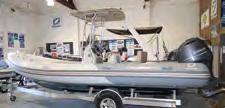



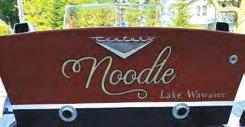

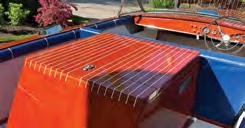
Keeping the 1967 Century Resorter in the family was not even a question. When the late Glen Hague purchased the boat in 1967, there was only one place for it: Lake Wawasee in Syracuse, Indiana. When some engine issues landed her in his garage, there she stayed until 1982.
Time and the elements took their toll, but the boat remained solid and the mahogany was in good condition, albeit dirty. The engine and cushions needed work too. It was a project boat.
After Glen passed in 2020, there was talk amongst the family about who wanted it. Glen’s youngest daughter, Nanci Browne, and her husband, Todd, have had a house on Lake Wawasee since 2015. They were the obvious new owners of this beauty and had the desire to restore her and bring her back to the only waters she’s known.
Lake Wawasee is a haven for vintage wooden boats. Every Sunday during the summer, the “Thunder Run” takes a parade of classic boats — sometimes 50 or more — on a morning cruise around the lake. It’s a time-honored tradition of pure Americana.
This summer, Noodle (Glen’s nickname for Nanci) has taken up residence in her rightful place on Lake Wawasee. Noodle is now a fixture in the Thunder Run with her blue cushions, gleaming mahogany and engine roar, bringing joy once again to the only water and family she has known.
—Joe D’Onofrio
